#the first version of this was drawn in like 2021
Explore tagged Tumblr posts
Text
The Ice Phoenix

The Ice Phoenix is known for its amazing adaptations to the icy landscape that it calls home. Its longest flight feathers are shorter than they appear, owing their apparent length to a delicate encasing of ice that extends the feathers and allows the phoenix to fly. For this reason, the ice phoenix is unable to take flight if the ambient temperatures rise above freezing for too long as the creature’s body temperature can only keep the ice frozen for a limited amount of time. Without this ice, the phoenix is grounded and immensely vulnerable.
Indeed, the frigid body temperature of the ice phoenix is another marvel, so cold that the mere touch of liquid water can spell disaster, nearly instantly freezing around the phoenix’s body. It is beleived that this low body temperature is what causes the shimmering trails the phoenix leaves behind while in flight; the water in the air freezing as the phoenix passes through. Despite the danger that water may pose, the ice phoenix has a habit of gliding right above the water’s surface, seemingly just to watch the water beneath freeze over. Still, mystical as the creature may be, it still requires water to sustain itself, and it extracts this water through the small mammals it hunts. An opportunist, the ice phoenix will also eat small fruits such as berries when available, but they make up very little of the creature’s natural diet. When dehydrated - or even in the effort to keep its curved beak sharpened - the phoenix will go as far as consuming ice directly, trusting that it will thaw thanks to the creature’s only slightly warmer core temperature.
In displays, be it for courtship or warning, the ice phoenix will use its stunning, frosted wings and snow-dusted markings to show off. But no feature is used more than its long tail feathers, spotted with bright circles that catch the light even in the midst of a snowstorm. Sometimes, it is these glinting markings that a small prey item sees last before the phoenix descends upon it.
#the first of 12!#very excited#the first version of this was drawn in like 2021#a long time coming#gonna be a fun 12 weeks#SeasonalSundays#Winter#Ice Phoenix#phoenix#digital art#concept art#creature concept#creature art#animal art#my art
1 note
·
View note
Text
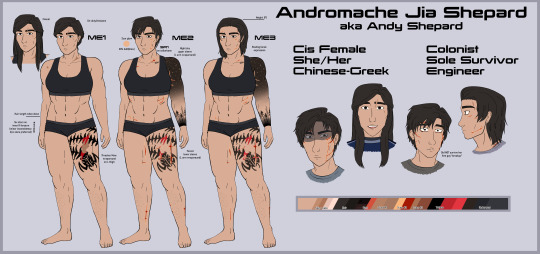

Revisited my old Liaramancer, Andy (also the only character I've played through the entire trilogy) after like 2/3 years! Probably the biggest ref I've done for a character haha
More character info +ID under the cut:
Andromache "Andy" Jia Shepard Age: 29/31/32 (ME1/ME2/ME3) Morality/leaning: Paragade Sexuality: Bi + demi Romance: Liara Weapon(s) of choice: Sniper rifle, tech
Born in Thessaloniki, Greece, as the middle child of five children, Andy moved to the off world colony Mindoir with her family at the age of 10. They lived a peaceful life there for six years before the colony was attacked by batarian slavers, leaving her the only survivor of her parents and siblings. She was taken in by her aunt and uncle, and moved to Vancouver, Canada, to live with them. She studied computer engineering at a military school in the city, eventually transferring into the Alliance military after graduating.
Most of Andy's military fame prior to serving on the Normandy is attributed to her experience on Akuze, where she was the sole survivor of fifty-one marines after a thresher maw attack, managing to get back to the extraction point thanks to her perseverance, quick thinking, and sheer luck. After this incident she was admitted into the N7 operative program, eventually graduating and earning the rank of Commander.
When on the job, Andy is clipped and professional, always trying to act reserved, though at times her emotions get the better of her. Outside of work, she struggles to connect with people and has difficulty turning her "professionalism" switch off, though she tries her hardest to be approachable. After her "death" and subsequent reconstruction (in ME2) she is much more brutal and upfront. Feeling like her life and all control of it was yanked away from her, she cut her hair and got new tattoos as a way of leveraging some control of herself. Although she ultimately wants to help others, she feels bitter and angry at the fallout of her death and the organization that resurrected her for their own means, Cerberus.
By the time of the Reaper war (ME3), she has mellowed out considerably on a personal front, having found more stability in her personal life after reconciling with her old connections and breaking away from Cerberus. However, the stress of the war and the decisions accompanying it weigh on her every day, and she tries her best to present a calm and collected front to keep up crew morale.
In her spare time, Andy enjoys programming equipment and putting things together, along with working out. She is also a massive fan of romantic dramas and tries to keep up with them regularly.
[ID: Reference sheet for Andromache Jia Shepard/Andy Shepard, a masculine 5'0" Chinese-Greek woman, across all three mass effect games. The first image shows her changes in scars + tattoos across the games. In ME1, Andy has a thresher maw tattoo on her L thigh along with six stars on her R inner forearm and long dark brown hair tied back in a bun (or worn down for casual wear). In ME2, she gains red scarring from reconstruction (ME renegade scars) on her face and various parts of her body, along with a L sleeve tattoo consisting of a night sky on the upper arm and a forest on the lower arm, along with a L collarbone tattoo reading "SR1". Her hair is cut in a short and choppy haircut. In ME3, Andy's hair has grown out to her shoulders and she wears it pushed back. Her red scars have faded somewhat but are still present. The points on the first image read "Cis Female, She/Her, Chinese-Greek, Colonist, Sole Survivor, Engineer - The second image shows her outfits across the games- In ME1 she wears the standard Alliance military outfit, in ME2 she wears military cargo pants with a grey muscle t-shirt, and in ME3 she wears Alliance military cargo pants with a grey muscle t-shirt and the red and black N7 hoodie. Andy also wears an iron ring on her R pinky at all times. End ID.]
#andromache shepard#shepard#femshep#mass effect#commander shepard#ktmart#her long hair is iconic to me but...i reallly like the short versions lol#sorry andy i havent drawn u since... 2021? 2020?#for the sniper rifle thing - i play all my classes except vanguard like snipers bc infiltrator was the first class i played
57 notes
·
View notes
Text
Werewolf: the Apocalypse 5th Edition and the Anti-Indigeneity in the Gaming Industry
reosted with permission from J.F. Sambrano
Dagot’ee!
Shii J.F. Sambrano gonsēē. My nations are Chiricahua Apache (Ndeh) through my maternal grandmother and Cora Indian (Náayarite) through my maternal grandfather. I am a mixed race Indigenous person, and through my father my heritage is English and Scottish. I am currently residing and doing work in my community on the lands of Lummi Nation. I use both gender non-binary and masculine pronouns, but prefer the former. I have several published works in the TTRPG industry, and am probably most known for my contributions to Mage: the Ascension 20th Edition, Werewolf: the Apocalypse 20th Edition, and the Transformers Roleplaying Game, as well as being part of the Essence 20 development team. Further, I also work in higher education at an Indian college, both advising and teaching Indigenous students across the United States. My passion is education, and I believe that we all learn through play, and that TTRPGs are a valuable source of learning, especially on personal, cultural, and social levels. This has always been what has drawn me to TTRPGs since I started playing M.E.R.P. with my brother in 1996 (and before that HeroQuest), through to my “graduation” into more story-driven games such as those presented in the Storyteller System, until now, where I author and produce my own roleplaying games.
I was also part of the First Team (in-joke intentional) hired by White Wolf Studios/Paradox Interactive via Hunters Entertainment to develop and author Werewolf: the Apocalypse 5th Edition. After several months of work, Paradox Interactive chose to go in another direction in early 2021 (I believe it was either March or April) and in fall of that year, it was announced that Werewolf would instead be taken in house, with Justin Achilli as the Brand Creative Lead and primary author of the book. Going forward I will be describing my experience while I worked with Paradox Interactive, primarily through Karim Muammar, White Wolf’s Brand Editor, as well as the developmental editor for Werewolf. Although I worked in a team, both with hired authors and in-house representatives at Hunters Entertainment, I will not be speaking for the experience of others, except when specifically noting unanimous consensuses, and specific interactions (which will go unnamed) that are particularly relevant. My hope is that by highlighting some of the anti-Indigenous attitudes that are central to the foundational members and leaders of the White Wolf brand, that I can provide opportunities for growth and healing within the World of Darkness TTRPG community, but also in the broader gaming community, where these behaviors and attitudes are rampant. I also want the community to have a better understanding of what this experience is like internally, and the challenges that Indigenous creators, as well as other marginalized creators, are met with when they try to make positive change within nerd and geek communities clinging to inherited white supremacist values, even if they don’t realize they are doing so.
What I do not want to be doing in this article is creating fuel for edition wars. I believe that both legacy and Werewolf 5th are rife with anti-Indigenous attitudes, and appalling amounts of appropriation. Both versions deserve criticism, I am not defending one over the other, I am only sharing what my experience was like working on the 5th edition of the book. Further, please understand that I was originally going to wait until I had read the final copy of the book, because I wanted to know how much of my work was used (based on previews I already know some was, just not the extent) and whether or not they decided to credit me for that work, and how I was going to be credited. My belief is that I likely will not be, but I am genuinely uncertain. Knowing how they handled that would have reframed how I addressed this. But more importantly, I want it to be very clear that even before Paradox ultimately pulled the plug on the Hunters team, I was preparing to exit working on the project based on the experience I will describe below. Not only did I find it frustrating, and personally disparaging, but I ultimately decided I was uncomfortable with my name being attached to the product based on the direction they wanted to go. So while I wanted to know whether or not I would be credited, because it would teach me something about their internal practices, I do not want or need the credit.
Finally, the reason that I decided to speak about this now instead of after having a chance to inspect the final product, was because my personal experience dealing with anti-Indigeneity coming from Paradox was just that: personal. But since then I have witnessed a throughline of hateful and xenophobic attitudes wielded against Indigenous people across the globe, and we do not deserve this treatment. I was outraged over the events that led to the segregation of the Latin American fanbase, which culminated from bottom-up criticism about how poorly their people and countries were being defined through World of Darkness products, and ended up with the firing of their Latin American Brand Ambassador, Alessa Torres, because she chose to stand with her community in those criticisms. I was further appalled when the likeness of Tāme Wairere Iti was shoehorned into the Werewolf book, a blatant example of cultural theft: not only in stealing the literal physical identity of an Indigenous person, but also his sacred tā moko. When Paradox Interactive issued an apology for this, it felt incredibly hollow to me in the wake of these events, the hateful attitudes I had personally witnessed coming from the top.
Whether from North America, Mexico, Brazil, Argentina, or Peru, or across the globe in New Zealand, not only do Indigenous people deserve better treatment from such a major company, but their Indigenous and Latino fanbases, who have twisted and worked themselves through difficult representation for decades at this point, deserve better. Apologies are not enough, especially when they come with next to no real change.
Werewolf: the Apocalypse in Context
At the time that White Wolf Publishing began to produce its World of Darkness line, the TTRPG industry was dominated by white men, both as producers, developers, and authors, as well as the main characters in their settings. White Wolf's World of Darkness made an impact at the time, by defying these Eurocentric, patriarchal presentations, first by defaulting to feminine pronouns throughout Vampire: the Masquerade, and then by focusing on Indigenous representation and values in Werewolf: the Apocalypse, and as a young Indigenous nerd, it had a positive impact on me, as I know it has on some other Indigenous people who became fans of the World of Darkness at the time. This was because before opening the pages of Werewolf: the Apocalypse, I had never seen heroes that I could play who looked like me and my culture. It was off, and often offensive, but it was my first experience in which I could directly play a hero who shared my heritage--and I also had more than one option through two different Tribes to do so. This might sound a little like I was cheering for table scraps, but again, at the time, table scraps was more than I had ever seen before.
Werewolf: the Apocalypse 1st Edition was originally published in 1992 via then White Wolf Publishing (not to be confused with Paradox Interactive's White Wolf). From its inception, the premise was interwoven with what its then-authors believed to be Indigenous praxis and representation. Like many pop-culture presentations of Indigeneity from this time period (see Fern Gully, Dances With Wolves, Disney’s Pocahontas, or in TTRPGs, the NAN from Shadowrun) it was rife with problematic and even offensive stereotyping. The most obvious examples thereof are within the two "Pure Tribes" Uktena, and W****** who I will henceforth refer to as Older and Younger Brother. However, Indigenous inspiration was at the core of the game's spiritual premise as well, where animism and "Totems" are central to the setting and gameplay. The way these concepts are presented is trivializing and dehumanizing, but it is important to acknowledge that the appropriation present in Werewolf: the Apocalypse goes a lot deeper than the two Brother Tribes (even the term "Tribe" was meant to invoke a vision of Indigeneity compared to the previous setting in the line's use of "Clan"). Additionally, there is art throughout every generation of these gaming books that represents humans, wolves, and human-wolf hybrid forms wearing Indigenous regalia, including sacred items such as headdresses, or engaged in sacred rituals such as the Sun Dance. The list of problematic representations goes deep, and my examples only scratch the surface, but it is also important for me to note the positive impact that this had, particularly in the 90's.
Even though the primary contributors to these narratives were non-Indigenous authors, or in one case, a Pretendian, and another, a culturally disconnected author, by the time the Revised (or Third Edition) era of the books came around, White Wolf Publishing was actively engaged in cultural consultation. While I do not believe cultural consultation makes a big difference on its own, it matters that the attempt was made, to a degree: while these efforts fall short of what needs to be seen in cultural representation, this was still ahead of most other gaming companies at this time.
Hired by Hunters Entertainment
In February of 2020 I was approached by one of the co-owners of Hunters Entertainment to be one of the primary authors for Werewolf: 5th Edition due to my work on other World of Darkness projects, and let's be honest, because I was capable of bringing a much needed Indigenous perspective to a gameline that was rooted in Indigeneity and rotting with appropriation and racist stereotypes. I was overall receptive to the invitation, largely because I was very passionate about the World of Darkness setting overall, and Werewolf in particular, due to the impact that 90's representation had on me when I was a younger gamer. I also felt hopeful that with a really hard rewrite of Indigenous aspects of the game that I could shift a lot of really painful aspects of the game into something that was a net positive for Indigenous representation. I will tell you now, more than anything, I was excited to rewrite the Younger Brother Tribe, because when separated from racist authors, their message is very empowering and real to my lived experience.
That said, I did not agree to join the project without first asking for reassurances. I said that I was not willing to write negative Native stereotypes. I would not use appropriative language, or generally engage in appropriative writing (which meant at minimum that the names of the Pure Tribes would need to change), and most importantly, that I would not not engage in writing that contributed to erasure. While the person who recruited me to work on the project was eager to work with me, he acknowledged that he was not sure he could get everything I wanted to see approved, but also promised to fight for everything I suggested as hard as he could. Additionally, he shared with me that the original setting pitch for W5 involved all of Younger Brother being slaughtered en masse in a massacre. I made it clear that this was exactly the kind of thing that I would not write. I cannot remember if this was something he suggested to be changed before or after I was invited onto the project, but with some pushback it was changed. However, I point this out because I want you, the reader, to understand how eager Paradox Interactive was to start with mass genocide and erasure as a foundation to the setting. All that said, I cannot stress enough that I have had nothing but positive experiences with Hunters Entertainment, and none of the following concerns fall upon them.
The Sword of Heimdall
The first encounter the Hunters Entertainment team as a whole had with problematic guidelines for the W5 draft was the direction that Paradox Interactive wanted to go with the Sword of Heimdall. At the time, the suggestions from Paradox and Karim Muammar were that the Sword of Heimdall was going to represent the new major villain of the Werewolf setting, and that they were to also represent the far-right, fascist direction that Werewolf society so often turned toward. They were meant to be representative of how far the new concept of Hauglosk could take entire communities. However, the Sword of Heimdall was discussed interchangeably with the Get of Fenris as a whole, and more than once Muammar seemed to suggest that every member of this Tribe was guilty of the same attitudes espoused in previous editions from the Sword of Heimdall. Now let's not beat around the bush: the Sword of Heimdall are literal Nazis. They believe directly in white supremacy and don't shy from it. They wanted to cleanse impure elements from the Get of Fenris, including BIPOC people, other non-white ethnicities, women, neurodivergent Garou, and other disabled Garou.
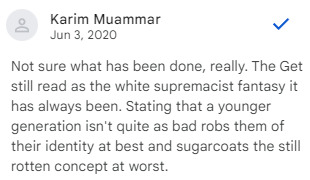
The writing team found this approach problematic for several reasons. The first, and most obvious, was that the direction seemed to want to turn one of the most popular Tribes into a horrific stereotype of its most abhorrent faction. Whether or not Muammar’s goal was to turn them into villains, we could not imagine a world where fans of previous editions would get their hands on this book, and not look for a way to play one of their previous favorite groups, thus creating the issue of making a guide to playing Nazi. Even beyond that, it’s not as if historically there were not players who used the tools of the setting to play Black Spiral Dancers, why wouldn’t this draw people who actually wanted to role-play through these toxic, harmful politics? Further, and while this is less important, it left a bad taste in my mouth, the justification for this major shift in Werewolf lore seemed to change over each pass. At first, Muammar suggested that all Fenrir were Nazis/SoH. Then, when he was provided with evidence that it was a small faction that was eliminated in the early 2000’s, he started to shift toward the idea that we should not follow the lore. Finally, when every single member of the writer’s team flatly refused to provide what would essentially be “a player’s guide to being a Nazi werewolf” the writing was on the wall about the end of our involvement with this product. More than once, he suggested that we were cowardly social justice warriors for being unwilling to work with this concept, even though there were several attempts to write a heroic version of the Fenrir that were focused on undoing these ills of the past.
Indigenous Erasure in Werewolf: 5th Edition
While the entire Hunters Entertainment writing team was handling the major, glaring issue of Paradox’s fervor to include a major Nazi element in Werewolf, I was personally dealing with the problematic approach to the Indigenous issues in the setting. The largest problem, for me, was in addressing Younger Brother’s issues, the history of non-Indigenous writers creating horrifically racist stereotypes, and what was valuable in the Tribal identity that should be saved and recentered. However, my attempts to do so were thwarted with every approach. I rewrote this Tribe four times, and offered three different versions of it to try to earn approval for a final write-up, but each time there was a lot of negativity directed towards my attempts and all them boiled down to this: Muammar felt that having two Tribes (both Younger and Older Brother) representing the “Indigenous population” was too many, and wanted them to only be focused on Older Brother, and that Younger Brother’s connection to a central, Indigenous identity, was undesirable because “other sources wrote them as having Siberian and European connections” and that future writing on this Tribe would require a lot of sensitivity…suggesting that one, Muammar wasn’t interested in doing the work to handle that level of sensitivity, and further, that he wasn’t interested in including me in future work, since I was involved with doing that at the time.

I want to take a moment to remind you that the work that was put into recovering Younger Brother started with “Let’s Kill Them Off” and at this point, through a combination of convincing and pleading, had been walked back to “They can live, but now they’re not connected to being Indigenous anymore” which is just representative genocide of a different variety. “Kill the Indian in him, and save the man.” It was also explicitly something I said I would not write about going into this project. Ultimately, my efforts did not get much further than this, with some specific exceptions I will cite below.
Karim Muammar’s Anti-Indigenous Positions
Muammar consistently and repeatedly communicated to the team in ways that were condescending and dismissive of our collective accomplishments and capabilities, but from my perspective, no one suffered as much significant derision as I did while discussing the changes I wanted to make to Younger and Older Brother in order to make their representation empowering and exciting.
In the pulled quote from the previous paragraph, I want to point out to you that Muammar, who had the title of Lead Editor on this project, refused to capitalize Native American. Further, he would often redline my work with edits to decapitalize my own uses of Native American, as well as the word Indigenous when referring to Indigenous peoples. While there are plenty of people who might want to argue about this, I will point out that both the AP style guide as well as the Chicago style guide (the one which I am most familiar with in my academic historical work) both call for Indigenous to be capitalized when referring to a people. Further, I challenge anyone to defend the consistent decapitalization of Native American. More importantly, the reason that these are standards in respected style guides, is because the English language has been used historically to oppress and erase ethnic identities, including Indigenous identities. By transforming adjectives into proper nouns, we are declaring that Indigenous and Native aren’t descriptors that can be applied to animals, plants, and soil, but real lived identities and culture groups.
When I was explaining to the Paradox team (which was mostly just Muammar) why it was important to change the names of these two Tribes from the appropriative (and offensive) ones used in the past, Muammar pushed back by defending the previously used Younger Brother name, even after reading my extensive research and explanation about how this would harm Indigenous communities and fans.
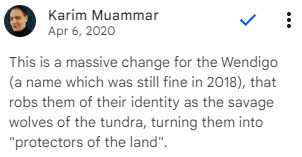
While doing so, he also decided that it was appropriate to refer to this entirely Native American tribe by the word “savages” a slur that has been specifically used to dehumanize Native Americans, and then mocked my rewrite that focused on presenting them as stewards of the land using Indigenous methodologies and praxes, instead of the “savage” racist stereotypes they were presented as in previous editions. Further, as in the above quote, even after it was communicated that the use of this term was problematic, he kept doubling-down to use it to refer to the Tribe.
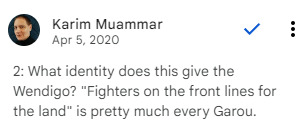
Even though I worked hard to redefine Younger Brother through Indigenous theory, such as place-based theory, relational theory, and communal theory, Muammar either refused to recognize this work, dismissing it as simple, or else simply could not understand the importance of these changes. Either way, the choice is that he didn’t want them to change, or couldn’t comprehend why the change was important because of how entrenched in white supremacist thinking he is. Further, after the massive effort that I put forward to attempt to educate him and the rest of the Paradox team on these issues, the insistence on using offensive terms and belittling my work felt intentional. So let’s talk about the work I did that was above and beyond my job description: free cultural consulting work.
“Sensitivity” and Consultation
I have seen several misunderstandings of my role working on this project going around, so I want to make something very clear. I was hired to work on this project as an author, and nothing else. I was not ever hired to be a cultural consultant. I do not do cultural consulting work. While I feel that there are many creators and companies who hire cultural consultants with the best intentions in mind, their responses often fall short of what is needed, as no one is ever obligated to actually follow the advice of cultural consultants. Further, I think there are also many companies who choose to hire cultural consultants only to say “we did this minimal step, and that is enough” in order to ward off naysayers.
However, anyone who hires me gets some level of cultural consulting for free, because it comes out in my writing–in both what I won’t write and what I choose to center my writing around. In the case of Werewolf 5th Edition, however, it was far more involved than this. I came with a plethora of “I will not write X” because I knew the setting was so problematic. A short list of my demands besides not being willing to write Indigenous erasure, was that we needed to change the names of the Pure Tribes (and the term Pure Tribe itself), we needed to change the word Totem to Patron, and also the Patrons of the Pure Tribes. We needed to move away from the term Metis for obvious reasons, and we needed to move away from the term Skin Dancers. I also specifically noted that there was a lot of cultural theft happening from the beginning of Werewolf until now that I wanted to address. The only way these issues were going to be addressed was to convince Paradox they were actual issues on the level of PR concerns, because nothing else was likely going to be considered. So in order to achieve this, I put in weeks worth of research, writing, and meetings with top level administrators with Hunters Entertainment so that they could bring this information to Paradox. I never documented my hours, but I would guess that I did approximately 80-100 hours of what I could only describe as cultural consultation work for free that was outside the contract work I was hired for. Let’s be clear: I did this willingly because I was passionate about the positive changes I wanted to see in this product, because I believed that Werewolf’s historic ills could be turned toward non-toxic representation.
Besides my actual words, such as naming the Ghost Council, and arguably the name Gale Stalkers came from a combination of names I pitched to Paradox after Winter’s Teeth was denied, and several sentences and paragraphs that I have seen so far that appear so close to what I originally wrote that you could imagine they were just edited versions, my largest contribution toward the final version of Werewolf: 5th Edition was this work. The only reason the offensive, appropriated names were changed were because of hours of my work to convince them it needed to happen. The reason that the Gale Stalkers aren’t just dead and gone: again, I pushed against this. The reason that Skin Dancers, Totem, and Metis will not appear as canonical titles? I pushed against their unwillingness to alter these things (see Karim’s defense of Wen**** Tribe name above).
Further, and this is the biggest reason I decided to write this article before seeing the final version of the book, I want to mention that I was also included in discussions with Hunters Entertainment to potentially be part of the art direction team, especially to oversee depictions of Indigenous characters, regalia, and art, to ensure that it would be represented either respectfully or not at all. I decided I needed to speak as soon as possible after the artistic portrayal of Tāme Iti appeared in the Glass Walkers preview without his permission. There are many arguments surrounding this issue and I am not going to address everything, but ultimately, I can tell you that had I remained as part of the art direction team, and saw that, I would have questioned it immediately. Even if I didn’t recognize Tāme Iti immediately, I would have asked what the source was on the depiction of moko in that piece, because I am aware that this is a sacred form of art–and I had already discussed wanting to make sure things like Crinos in headdresses didn’t appear in the book (as had often happened in previous editions, particularly on a certain white-skinned character whose name rhymes with Steals-the-Past).
As time working on this project went on, and I went through rounds and rounds of trying to convince Muammar and Paradox that it was important to not steal Indigenous identities, art, and stories, and that a greater effort needed to be put in powerful and empowering Indigenous representation, and I constantly ran into refusals and criticisms that were clearly hateful toward Indigenous identities and peoples, not to mention the push to represent Nazism as a major part of the game setting, I grew increasingly frustrated and restless with feeling like I was trying to work on a challenging project while also defending my right to exist as the person I am at every turn. Eventually I turned to another Indigenous TTRPG and game creator to ask for advice, and after a long and difficult discussion, I came to the conclusion that I was going to talk to the Hunters administration team and tell them that if Muammar kept using slurs and other anti-Indigenous language and attitudes, I was going to need to step off of this project, because it was harmful to me on a personal level. In furtherance of this point, I have been avoiding doing any contract work at all where I can tell that I am wanted for my specific cultural perspective ever since, because this situation was so harrowing for me.
Unfortunately, before I could have this conversation, after one final draft of Younger Brother and Bone Gnawers (which had its own issues, but that is not the point of this discussion), before we received any other specific feedback, the Hunters Entertainment administrators announced to the writing team that Paradox had decided to take the book in-house, and would no longer need our services.
The main point I would like to leave you with, besides these few specific quotes (out of dozens and dozens) that Muammar made that were anti-Indigenous, is that there is often a big call to have more BIPOC voices in various entertainment industries, so that both our stories, perspectives, and unique views on how the universe and life works, can be included; so that an industry that is historically, harmfully Eurocentric, might turn toward new, healthier, and inclusive directions. And I agree with this call for change, but I implore you to consider the conditions that BIPOC creators often have to work under: doing cultural/identity work and consultation for free as part of being present, being subject to vicious refusals of our experiences and perspectives, and straight-up having slurs lodged against our work. I want to see these changes in the industries we love, including the gaming industry, but currently the people who are in charge, who have the most power, are severely hostile to our work and our perspectives. This is why, for example, works like Coyote & Crow were done with an almost entirely Indigenous group of creators, and led by Indigenous creators, because trying to work for and with this ugly, hateful, and xenophobic group of people is so often exhausting, both mentally and spiritually, and because no good changes end up being made.
I am glad the harmful, appropriative terms were removed from the setting. I am glad I was part of the fight to make that real. I am not so glad that I was treated with hostility and racism by Muammar for the effort and love I put into this work, and I am not so glad that I will certainly be reviled by one of the two communities I did this work for–the gaming community, and certainly the people in power in this industry–and I am also not so glad that I didn’t have the opportunity to properly acknowledge how much of Werewolf’s base themes and setting are twisted and tied-up in Indigenous appropriation without giving the proper acknowledgments.
More than anything, I hope that this story will help you, the fans, realize that there is a lot of darkness in these communities, and they won’t change unless you hold their feet to the fire.
Ánaagodzįįhł
J.F. Sambrano
#decolonization#ttrpg#werewolves#writing#world of darkness#werewolf: the apocalypse#werewolf the apocalypse#mage: the ascension#vampire: the masquerade#changeling: the dreaming
3K notes
·
View notes
Text

REDRAW Venture Bros S01E10 "Tag Sale— You're It!"
→ → to all Billy Quizboy & Pete White posts
The scene where Mr. White and Master Billy (they didn't have full names yet) try to sell Dr. Girlfriend on becoming their nemesis opens with a tilt (camera moves up-down on X-axis), which I patched together from multiple screenshots.
This episode is officially Conjectural Technologies first appearance post-pilot, but the episode order was scrambled. Even as early as this episode is, when everything looked kinda “off” in general, in this scene in particular the proportions are very odd.
Dr. Girlfriend is enormous. It's not from a forced perspective/"wide lens" effect since even White is looking up at her— she really is like 7 feet tall here. The stretch is somewhat hidden by the tilt. She's supposed to be barely 5' (according to Doc on a commentary track)— a petite lady. Meanwhile, Billy's way too small in the shot. He's usually level with White's top row of buttons.
I rejiggered the proportions while faithfully recreating the poses, which I find both static/boring (the boys) + weird (why are her hands posed like that?) If I recall, I don't think anyone moves in this shot, just the simulated camera angle, so it may have been one drawing so no one could move, explaining the stiff poses.

Looks like I accidentally created a new subtext. White gives Billy judgemental side-eye for looking up with reverential joy at Dr. Girlfriend about to bless him with a laying-on of hands on his big ol' melonhead.
When I've drawn White with his parasol before, I used the typical Japanese design. I considered maybe the canon brolly might have been based on a Thai (or another Southeast Asian culture's) design. When it comes back in a later episode it has more of an inverse curve to it that you see in old temple roofs.

I've searched everywhere for a real life parasol with this design. Nothing. The closest I can find are big beach umbrellas at fancy resorts, but they aren't open at the top with criss-crossing ribs. Venture Bros takes place in a world very much like ours, but with subtle differences. This umbrella is one of those differences.
In my redraw, I added a Santa windsock. If you don't know why, turn in your fan club card, you POSEUR.
I found this abandoned drawing on my backup drive from 2021. Decided to finish it as self-care. (I'm moving in two weeks and very stressed out.)
First time (kinda) drawing Dr. Girlfriend. Only my fourth VB character drawn after, like, four years? Fifth if you count the Rusty Venture action figure.
What did they do with the Santa Windsock? Which one wanted it? Did Venture refuse sell it to them after he threw a snit over the Shrink Ray? He claims he won't sell the Shrink Ray to them in that scene (because they said the logo was stupid), but then they have it (in pieces) in their possession when he comes looking for it in Escape to the House of Mummies (Part II)
→ to Master Billy Quizboy & Pete White index
edited to add a further idea....
If only the show had an unlimited animation budget, it'd be more in character for Billy to be jumping around and gesturing wildly while making his pitch to be her nemesis. Sweaty. Hard sell.

...and smoking. (My version of Billy smokes.)
#screenshot redraw#redraw scene#redraw#billy quizboy#pete white#dr. girlfriend#adult swim#vbros#venturebrothers#venture bros#art#illustration#illustrator#adobe illustrator#digital illustration#digital art#vector illustration#vector art#season 1#tag sale#yard sale#vector#graphic art#dtiys#draw this in your style
116 notes
·
View notes
Text
Since my comic TTRPG Masks of the Masks has been out for a year now, I wanted to post some stuff from the development of the game.
So first I'll be talking about The Heir.




These are some of my first sketches of The Heir, drawn in October of 2021. At that point, the idea of the game being a fully illustrated comic seemed impossible. I only actually planned on illustrating the cover, and three panels on each character sheet.

Those sketches eventually became these panels on the original character sheet. The middle panel was later repurposed for the cover of the game. I felt like the imagery was too important to just scrap.
The questions in the text boxes were The Heir's original backstory questions. Vague and without answers. I still like them, but they don't provide a lot of utility for character creation. Striking the balance between being poetic and providing tools was an interesting challenge with this game.

Similarly, all the Masks originally had to write in their Assets and Identity instead of choosing from their own lists. Much like the backstory questions, that was changed so all the Masks would be more focused and specific. Except The Heir still kinda has to write their own Assets and Identity. They can't just write anything, but their options are all the ones from the other Masks.
It's just a small way some early design found itself in the final product, and I really love it. Also it slightly mechanically separates the Heir from the other Masks in a really interesting way to me. I think the fact that it's just a few more steps to find your assets and identity as an Heir feels so thematically appropriate, as well as the fact that they're essentially taking ideas from the other Masks.



Tying into the concept of "taking ideas from other Masks" here's some suit design is inspirations. Black suits with color accents felt like the perfect way to go for this character. I started with the concept that I wanted a vaguely Spider-Man inspired design. Miles Morales specifically was a huge inspiration for The Heir, so it was a good place to start. Though, the cloth mask is the only thing remaining from that initial idea. The lenses on the mask mostly mimic Nightwing's mask. The rest of the suit is an inverse of Nightshade's, but with full gloves and no boots. I'm not sure where the idea of exposed hair came from, and honestly it doesn't make much sense, but I love it.
Anyways to finish off this post, here's some unfinished versions of panels The Heir appears in.



Thanks for reading!
31 notes
·
View notes
Text
Batman v Ra's Al Ghul, by Neal Adams: A Bronze Age fever dream of a comic, written in 2019-2021.
Neal Adams caps off his over 50 year career with DC comics by...them letting him write a book for the first time in a decade.
Now, Adams is famous for his Bronze Age artwork, not his writing, and it's deservedly so: this is not the comic you would pick up if you were interested in award winning writing. But I have to say, it's actually something far more fun than 'good writing'.
I think the easiest way to describe the incredibly wild vibes of this title are 'Adams writes a multiverse Bronze Age time travel AU fic', where the cast technically consists of a modern set of characters (Dick is Nightwing and both Tim and Damian are Robin), but all of the characters are drawn, talking and acting like they just walked off a page in 1974 or so.


For assistance, that's: Dick in the yellow with the very 70s black vest; Tim in the blue t-shirt; Damian in the red t-shirt; and Bruce in the suit. You end up keeping track of them in this title by their haircuts.
Bruce and Damian here cannot remember anything about being Batman and Robin; Dick and Tim appear to have shown up with a fantastical story that cannot be proven (as I said, this has INCREDIBLE reality hopping AU vibes).
Some of the characters have been mindwiped. Some of the characters are robot duplicates. A whole list of characters Adams helped create show up largely because he created them (seriously Kirk and Francine Langstrom show up for a couple of pages mostly to give Dick and Tim an airlift into a difficult to reach entrance to the Cave). Nobody sounds particularly in character at any point, but that's not really a problem in this comic, because what it really is is a giant jolt of Bronze Age style writing nostalgia direct to the brainstem.


They don't make comics like this anymore and reading one written in the 2020s like this reinforces why.
Deadman's brother Aaron and sister Zeea show up; his brother is busy pretending to be an alternate Australian version of Batman called Marvin O'Hearn, and his sister is a psychic running around in the most 70s outfit imaginable controlling things and mindwiping Bruce on Ra's orders.
(And yes, if you too just asked 'Boston Brand has siblings???' the answer is 'kinda sorta but definitely not these two', however given Adams was writing Boston in 1968 at one point he's got as much right as anyone else to claim there are additional siblings)
There's a group who PRETEND to be the Court of Owls but secretly are a group of industrialists called The Money who want to control the world via paying for legislators, judges and industry (and yes I realise that sounds exactly like the Court's thing, but Adams was almost 80 when he wrote this, he can have an expy Court if he wants one).

Bruce pretends to be Matches for a good chunk of the back end of this comic and it actually acknowledges that Matches Malone was a real gangster before he died and Bruce stole his identity (something other writers and the fandom often forget), because Adams wants one more spin with the character he designed.
There's also a moment in the sixth issue where one of Ra's pet scientists tries to sell a panel of Gotham execs on a perpetual motion machine based on electrolysis as his replacement for the current Gotham power generators and at this point I lost it giggling at the portrayal of Ra's as a cheap charlatan.
(There is also a sneaky joke that only works if you know what British salad cream is; there's this sequence of the kids talking about Alfred making sandwiches with 'crappy salad dressing' instead of mayonnaise, only this tray has been made with mayo...and it's a hint that Alfred has been replaced by a robot. I laughed; I suspect it might be non-obvious to American audiences)
This is not a comic to read if you are interested in 'main continuity' or 'coherence' or even 'good writing'. However if you want some wild antics that feel like someone's 3am fanfic AU written in pure Bronze Age vibes and to see the last work of one of Ra's Al Ghul's creators? Give it a chance. You'll never be able to predict what's on the next page.

#z canon read throughs#recent reads#I cannot say it was a GOOD read#but it was certainly a hilarious read#god bless every person who worked on this and probably looked at editorial going 'are we really publishing this???'#there is a reason they don't let Neal Adams write comics most of the time
36 notes
·
View notes
Text
Jack Jeanne Complete Collection - Interview with Ishida Sui and Towada Shin Translation
This interview is from the Jack Jeanne Complete Collection art book, it’s available on CDJapan and Amazon jp. You can also purchase a digital only version on bookwalker jp. I encourage anyone reading to purchase the game (if you haven't already) or the art book itself to support Ishida and Towada directly. 💕
This is a VERY long interview so I apologise for any typos or errors I may have missed.
~ ~ ~

An interview with Ishida Sui and Towada Shin, who both worked on writing the story of Jack Jeanne. In this interview they reveal what went on behind the scenes during production, rejected story ideas and much more. This interview was conducted remotely on the 9th of February 2021.
Interviewer: Yui Kashima
How did Ishida Sui end up making an otome game?
—How did the production of Jack Jeanne begin?
Ishida: It was sometime around Autumn 2015 I think… On an old personal site that I used to run, I received an email from the company Broccoli to an email address that I no longer use. It was a commission request for character designs.
—In 2015 Tokyo Ghoul was still being serialised wasn’t it?
Ishida: Yes. Usually job offers like that go through Shueisha first, so I contacted my editor asking why this one was sent to my private email… At the time, in addition to working on Tokyo Ghoul, I was also drawing illustrations for a tear-off calendar and very busy with various other things, so when my editorial department heard about the offer they seemed very shocked like "What!?".
—Why did you decide to accept the offer even though you were so busy?
Ishida: I would often receive offers asking for me to draw manga or illustrations, so I figured that this one was a similar case. However, some words in the email caught my eye. Like ‘Gender Swap’, ‘Takarazuka’ and ‘All Boys Opera'. When I saw these concept ideas, a dream began to swell in my chest and I felt like giving it a try.
I think if it had just been a normal character design job, I would have turned it down. However just from reading the short brief in the email my interest was piqued. While in discussions with the Young Jump editorial department, I also casually mentioned the kind of offer I’d received to Towada-san.
Towada: Yeah, Ishida-san asked me for some advice. I was also drawn to the ‘Gender Swap’ and ‘Opera’ concepts. I could easily visualise the setting of the story. Additionally, it seemed like it would be a story that included many different themes such as gender. When I thought about that, I figured that Ishida-san would be a good fit, since I knew he would be able to draw something that went beyond all genders.
Ishida: I’ve been drawing androgynous characters for a long time, so Towada-san and I talked and wondered if that's what they must be looking for. After that, I created my own proposal and submitted it to Broccoli.
—You created your own proposal, Ishida-san?
Ishida: When I looked at the original proposal that Broccoli had sent me, a lot of it differed from my personal tastes. It was a very upbeat and dazzling story. It would’ve been hard for me to match my art style to that, so in my proposal I noted things like ‘if it were me, I’d do something more like this’. I was interested in this unpolished gem of a story, so I thought it would be a waste to turn it down altogether. I wanted to at least try throwing my own ideas into the ring, so I spent a week creating the six main characters and sent them in.
—At that time, I heard that the game wasn’t titled ‘Jack Jeanne’ yet, but was instead called ‘Jiemarie’.
Ishida: At first, I wanted to try creating a word that doesn’t exist. So using French as a base, I came up with ‘Jiemarie’ as the game's provisional title. But then a month later when I was reconsidering the title, I looked at it again and thought, damn this looks lame. So I hurriedly called Towada-san on Skype and we entered a discussion that lasted about ten hours over what the title should be.
That’s when we decided on ‘Jack Jeanne’. The male roles take the name from the knight, or the ‘Jack’ in a deck of playing cards. And the female roles ‘Jeanne’ take from the word parisienne and Jeanne d’Arc. When these two terms are put together, I feel like you can comprehend what the game is about with a bit of nuance. Plus you can shorten it to ‘JJ’… That’s also the title of a magazine though (lol).
—Taking on another job whilst your manga was being serialised sounds like it would be tough on you both physically and mentally.
Ishida: I think I must’ve been a bit unwell (lol). My body was fine, but being able to work on something other than a serialised manga was a lot easier on me mentally. I may have seen it as a way to escape, so I didn’t feel that working on two projects at the same time was difficult. When it comes to game development, I can only create what I’m capable of, and there was no set release date yet. Of course, I would work on and submit things whenever I could though.
—What kind of things would you submit?
Ishida: I would sketch character designs, discuss and create story elements with Towada-san and try to put Univeils history into chronological order. Then I would share the progress with Broccoli and have meetings and such with them. In the beginning, rather than having to draw anything yet, it was mostly just brainstorming and planning. That’s why I think I was able to do it all concurrently with the serialisation of my manga.
~ ~ ~
How Ishida Sui and Towada Shin know each other
—Do you chat with Towada-san often?
Ishida: Well yeah, she is my older sister after all.
Towada: We talk a lot. When we both have the time we chat over Skype.
Ishida: Once we start the conversation can last up to five or six hours. We mostly talk about things that happened throughout our day. When I’m talking to someone I often bring up something that’s happened to me and ask their opinion on it. She became someone that I could chat with whilst working on my manga. Ever since my student days we’d talk until early morning, I usually told her about storyboards I’d drawn.
—At the Ishida Sui exhibition it was revealed that Towada-san had even given you advice on some of your earliest works.
Ishida: Yeah that’s right. It was a work I’d prepared for a 'bring your own work along' induction course in Tokyo that I attended back in my student days. It was a manga about two characters who eventually became the prototypes for Tsukiyama and Hori Chie in Tokyo Ghoul. It was only about 30 pages long, however when I showed it to Towada-san the day before the presentation, she told me that she thought my linework was too thin.
Towada: Yeah, the overall linework of the manga was thinly drawn. Once I told Ishida-san this thought, he began tracing over his linework and making it thicker. And then when he looked at it again, he said “Yep, I need to redraw the whole thing”.
The linework being too thin was only my personal opinion and the presentation was in Tokyo the next day, so in horror, I began hastily telling him, “You won’t make it in time, stop, stop!”
Ishida: All I could think about was that the lines really were too thin, so I wanted to redraw it. All of the screentones had already been affixed to the panels, but I didn’t want to bring something along with me whilst knowing it wasn’t the best that it could be.
Towada: Ishida-san handled the linework and I helped with redoing the screentones. We worked throughout the night and finished redrawing the whole manuscript. Once it was done, it wasn’t even comparable to the previous version, the lines were powerful and the characters' expressions conveyed a lot. I was seriously worried though (lol), I didn’t know if we’d complete it in time.
Ishida: I couldn’t think about anything other than the lines being too thin, so I wasn’t even worried about whether I had enough time or not.
Towada: I fell asleep halfway through, but you continued and boarded that Tokyo bound flight without having slept a wink, didn’t you?
Ishida: Yeah. I let Towada-san sleep and continued applying the screentones myself right up until the very last minute. I was still applying them whilst on the plane and also after my arrival in Tokyo. I used screentone number 10 a lot, so I remember the scenery around me gradually began to look grainy like the screentone. It felt as though I was hallucinating.
—Sounds like it was a tough manuscript to complete. Towada-san was also the author for the Tokyo Ghoul novels, has your relationship always been one akin to work partners?
Ishida: When it was decided that Tokyo Ghoul would be getting a novelisation, I was given other authors' works to look at. However, none of their styles really clicked with me, and they didn’t seem right for the series. I knew that Towada-san wrote, so I tried reaching out to her.
Although back in the days of Tokyo Ghoul’s serialisation, Towada-san and I didn’t talk as much as we do now. If I had any concerns I would just try and sort them out by myself. We’d always gotten along as brother and sister, however we didn’t really start to have a ‘work partners’ kind of relationship until we started working on Jack Jeanne together.
Towada: That’s true. Back then, we only occasionally conversed regarding the novelisation of Tokyo Ghoul. Before :re we only spoke once every few months over Skype. As Ishida-san said, it wasn’t until I started working on Jack Jeanne that we really started properly talking to one another.
—How often would you contact each other?
Towada: Depending on what stage we were at, we would bounce ideas off each other once every three or so days. Ishida-san would make a request like “I’d be happy if this part of the script was done within the next two weeks.” And then I’d present what I’d written and we’d discuss it and then I’d return to writing again. This process was repeated until Jack Jeanne reached its completion.
—Was Ishida-san the one that reached out to Towada-san to write the script of Jack Janne?
Towada: He didn’t ask me specifically to write the script, early in development he’d ask me to help with some research like “I’d like you to look up some information on this, could you help me?”. I’ve always liked ikusei games and within that genre I also enjoy romance and otome games. So I think that’s why it was easy for Ishida-san to consult me about it. We’ve had a common interest in games ever since we were kids.
Ishida: Back then I played games like ‘Pinnochia no Miru Yume’ and ‘Angelique’. I wanted to try and conquer Marcel in Angelique but it was one difficult game, so it was a tough task. Before I could even raise any flags with him, the training aspect of the game was so hard that no matter how many times I played I never got any good at it.
Towada: I’m the type that loves playing games, so after talking with Ishida-san, I went on to play every popular otome game that had been released around 2015, as well as every Broccoli published otoge. I completed every single character route in those games. I began analysing otome game trends and Broccoli’s brand identity and relayed my findings to Ishida-san. After that, I went along with the Jack Jeanne production team and Makasano Chuuji-san from Shueisha, who was the scriptwriter of the Tokyo Ghoul anime. We all visited the city of Takarazuka for research.
Ishida: I was also supposed to be there for the Takarazuka trip but since I had my manga to worry about, I had Towada-san go and take in the atmosphere in my place.
Towada: I did have to gather material but I think I visited Takarazuka a total of five or six times. From morning I would watch the Takarazuka theatre from afar and simply watch the guests move about, soaking in the atmosphere of the city.
Along with the Takarazuka plays, I also watched student plays, in total I probably went and watched one hundred shows. Theatre shows that are performed by professionals are fully realised and flawless. So getting to see the contrast to student plays, where they progress and improve until the show is complete was a very helpful reference.
I’ve always enjoyed watching plays, so everything I had to research overlapped with my own hobbies. I still shared my own input with Ishida-san though.
Ishida: I’d never formally been asked to write a script before… I felt like a fraud (lol). I think it’s because I’m not very good at being considerate of other people. I don’t think I’d be able to work with anyone other than Towada-san on something.
—Why is that?
Ishida: Well, for one I don’t want to talk to anyone for long periods of time (lol). Because Towada-san understands what aspects of a story are important to me, she’s also able to comprehend what I mean when I talk in abstract concepts. We could save time by not needing to have any pointless discussions.
Towada: Back then Ishida-san was still very busy publishing his manga, so bringing in all sorts of new people to work on the project probably would’ve put quite the burden on him. That’s why I wanted to help him out in some way.
After researching all sorts of things, I ended up participating in a production meeting for Jack Jeanne, but I was not expecting that I myself would end up being in charge of writing the script. Rather, I was more just looking forward to getting to play a game made by Ishida-san. As things progressed though, I was asked to try plotting things out, or to write part of the script to be used temporarily. Eventually I came to think, why don’t I just write the scenario myself?
I’d never written the script for a game before though, so that’s what had been holding me back. Unlike novels, it’s commonplace to not have to write descriptively. Novels are made up of dialogue and descriptions, like describing the setting and characters' expressions or emotions. So I had to spend a lot of time working out how to write to properly convey a story through dialogue alone.
When I first started getting the hang of it, I tried writing a script that still included descriptions but I quickly stopped. Jack Jeanne is about theatre, so I figured that it would be easier to convey the presence and narrative of the story through conversation. I usually write novels, so I was uncertain, but since Jack Jeanne has sprites of the characters on screen, I thought that I could do it. I suppose it’s closer to writing for a manga rather than a novel.
~ ~ ~
The rejected character routes
—Before Tokyo Ghoul was completed, what kind of things did you work on?
Ishida: The first two years were mostly spent creating the game’s world and mechanics. Like deciding how many performances there would be, how the plays would be presented. Would it be a dialogue drama? Would there be mini games? Things like that. We also had to decide whether summer break would be included or not, how raising affection would work and how the choices would be presented. Those are the sort of things that were talked about first.
—You got to watch over the entire game’s development then.
Ishida: At first, I got carried away and envisioned a stage play game full of skill mechanics that I personally enjoyed. A busy game full of specs you can raise and improve in mini games, however when I explained these details to a friend of mine, they were like “You’re just imagining a game that you would like, right?”.
They asked me if that’s what the eventual players of Jack Jeanne would be looking for. That same friend said that since it’s a story that deals with the theme of theatre, it would be better if the player could witness the performances themselves. So I took that advice and the prototype of the current Jack Jeanne was created. I told all of this to Towada-san and had her handle the script.
Towada: You can’t write a script without knowing how the game’s system works after all.
Ishida: Now that I think about it, before Tokyo Ghoul was finished, rather than build the game's foundation, all I was really doing was scattering the sand to prepare for said foundation.
When Tokyo Ghoul entered its endgame especially, I really had to concentrate on it, so I took a six month break from Jack Jeanne. Ending a story requires a lot of energy and attention, so I left the practical work of Jack Jeanne to Towada-san and only supervised the music production and attended any important meetings.
—So during serialisation you were making preparations to jump right into it afterwards?
Ishida: Yes exactly. I wasn’t able to do much practical work, so I had Towada-san prepare the script in advance for me. And for the time being, create one character route.
—Which character was it?
Towada: It was Shirota. I wrote about the equivalent length of a short book and it was more or less complete. In the end, we scrapped the entire thing though… Because the atmosphere in the beginning was quite dark.
Ishida: It was dark because I was too used to Tokyo Ghoul. It included issues like a troubled household and severe bullying. Reading something like that wouldn’t put the player in a happy mood.
Despite it being a story about the theatre, my attention drifted to other topics which didn’t fit. And it was me who had asked Towada-san to write something like that… A couple months after the Shirota route had been completed, I read over what Towada-san had written for me once again and realised that it was a bit too gloomy. I’d forgotten what prompt I’d even given to her in the first place (lol).
The first character portraits and CGs that I created were for Shirota too. The reason being that Shirota is the only second year student and he was already a complete individual, so he was easy to create for. As for the third year students, there’s three of them, Fumi, Kai and Neji. Along with Kisa, Suzu and Yonoga are also first years, so continuity and character relationships need to be taken into account in order to create them, so they were a little more complex.
—How did the other characters come to be?
Ishida: At the proposal stage, the first character that I created was Kai. It’s a game where characters will be falling in love and confessing to one another, so first off I wanted a character that was handsome. Then I made Fumi who would be Kai’s partner. After that, I think Shirota was next.
Towada: At first you created the characters by basing them on plays didn’t you?
Ishida: I’m a fan of Yamamoto Shugoro’s work ‘Kikuchiyosho’ so Shirota was created using that as a base. In Shirota's case the genders are swapped, but Kikuchiyosho is a story about a girl who is born into a samurai family and raised as a boy. It has an element of androgyny and portrays the confusion and anger concerning gender quite well.
—How did you select the plays to base the characters on?
Ishida: I chose plays that lots of people are familiar with and would be easy to assign characters to. Kai is ‘The Phantom of the Opera’, Fumi is ‘Salome’, Neji is ‘Faust’ and Yonoga is ‘Shintokumaru’. Kisa and her classmate Ootori are ‘Don Quixote’. Ootori ended up becoming a side character though.
—So Ootori was originally meant to be a main character?
Ishida: Yeah. If I were to compare it to Tokyo Ghoul, Ootori is in the same position as Tsukiyama. I wanted a pompous character like that in Quartz. However I may have made him a little too unique (lol).
I received feedback from Broccoli that they want the main six characters to be an elite group, so a more easy to approach character would be better. So I moved the bright and cheerful character that I had originally made as Onyx’s Jack Ace over. That character was Suzu.
Making the characters personifications of plays started to become difficult to stick with though, so I abandoned the idea entirely halfway through.
—Despite appearing glamorous, the characters are all dealing with their own issues, like certain complexes and family troubles. I think that they’re all conflicts that are easy to sympathise with, how did you decide what the backbone of each character's conflict would be?
Ishida: First I created the character's appearance and then decided what personality would match them. Like with Fumi, when I began to think about making his story about the unique struggles that come with being born into a respected family, if becoming a successor was going to come into question, then he needed to have a brother.
In this way, I worked backwards from the vibe of his appearance and created his home life. I did the same with the other characters too, thinking things like ‘to have a personality like this they must not have parents, or they must struggle with expressing themselves’.
I think that if you let your characters do human-like things, then aspects of them that are easy to sympathise with will be born.
Jealousy, setbacks due to failure, inferiority complexes… Each and every character naturally ended up having some form of theme attached to them.
—I feel as though Kisa had a different sort of personality than that of a typical heroine.
Ishida: To put it simply, I want my protagonists to be fighting something. If they’re not giving it their all, then it’s no good. If they’re just standing around, then you can’t empathise with them.
—There’s times where she draws others towards her or supports those around her. She also has some masculine aspects to her.
Ishida: I think that I’m moved by characters who make me think “This kid’s really admirable”. That’s why I made Kisa a girl who works hard no matter the difficult situation that she’s in. I like Kisa and I’m sure Towada-san feels the same way.
Towada: She’s the result of both of our preferences. While due to the game’s setting, she of course has struggles related to being a girl, but I was careful to write the main thread of her story in a way that transcended gender and instead simply showed her charm as a human being.
—Regarding gender, I was impressed by how neutrally it was portrayed.
Ishida: Yes. Originally, I was going to make Shirota a character with a feminine personality, but I ended up scrapping the idea. In the end, he ended up having more of a masculine mentality. The premise of Jack Jeanne is that boys also play the female roles on stage, but it’s not a metaphor for anything and I didn’t want it to raise any questions. I simply wanted to give it my all creating plays with that setting and create something new and refreshing.
I don’t struggle with any gender related issues myself, so it’s not like I can fully understand what it’s like, but in general I’ve never considered gender to be a very big deal. If someone born male were to tell me “I have the heart of a woman” then I’d just think ‘ok cool’.
To me it feels strange to place so much weight on such an issue. I don't see why others need to be bothered by someone else's gender, I'm not since I myself am not able to speak for such experiences.
Towada: At first, it was possible to take that direction with Shirota but as I continued to write, I came to realise that there was no need to exaggerate any emphasis on his gender identity.
To those looking from an outside perspective, it may seem like a unique identity such as that is a person's defining trait, when in reality it's only just a portion of their whole self. If you consider it to be all they are, then you end up denying the other aspects of that person.
Whilst considering the individually of each character, I kept in mind to write them in a way that seemed natural for them.
—The side character, Tanakamigi Chui of Amber, had a very striking presence. How did you go about creating him?
Ishida: I wanted someone that’s easily understood to be the antagonist, so I went ahead and tried to draw someone who looked like an unstoppable genius. Despite being a second year, it’s as if he controls the school. I wanted an enigmatic and intriguing character like that. Once I named him Tanakamigi Chui I felt as though he was complete and his inclusion in the story was quickly decided on.
—On the flip side, were there any characters that you had a hard time creating?
Ishida: I had to think a little harder about the other members of Amber. They needed to have the aura of the enemy but since they’re only villains in the context of the stage, they’re not actually bad people. So it was hard to find that balance between them.
Visually they’re edgy and have a talented vibe, but they also have their own individual quirks, they’re not all homogeneous. I struggled with Kamiya Utsuri especially, I wanted him to visually look like he could be a Jeanne while also still looking like a boy, so it was difficult to get him right. I didn’t have to do many redesigns though and all the other characters came to be without much trouble.
What I actually had more trouble with, was the fact I made the cast too large. I initially created almost double the amount of first year characters, but when I looked back over the script that Towada-san created, I told her “There’s way too many characters, please cut some of them out.” To which Towada-san replied, “Ishida-san, you’re the one who created them in the first place.” (lol).
Towada: That’s because the cut characters had already appeared in the script (lol).
Ishida: I feel that when there’s too many characters a lot of them get wasted, so just like that I end up creating and scrapping a lot of my characters. I think even Broccoli were surprised by the amount of times I’d suddenly tell them “Oh that character doesn’t exist anymore.”
—Apart from characters, were there any other aspects of the game that were abruptly discarded?
Ishida: The performances I suppose… Originally I had wanted there to be a larger variety of shows, but if you were to put all of them in the script it probably would’ve ended up being three million characters long.
In the beginning of development, I had originally planned for each character's route to have a different final performance. There’s six main characters, and including Kisa’s route, that would total to seven unique shows.
Before that there’s the newcomers, summer, autumn and winter performances, so I arranged to have a script written for each. Basically I wanted to include more shows and increase the amount of sub stories, but that would be confusing to play through and development would never end. The game engine has its limits too, so I decided to keep it simple.
Towada: It would’ve been difficult to play through all that as well (lol). For the final performance, we settled on it being one show and letting the player enjoy it from each character’s perspective instead. And even then, there’s still over 20 different endings to the game, so it still took a long time until everything was fully complete.
—Newcomers, summer, autumn, winter and the final performance, were these five show’s scripts all original?
Towada: Yes. However at first, like the characters, we had planned to base them on famous productions. Like Shakespeare or fairy tales. We figured that players would find it easy to get immersed in plays that they were already familiar with.
Ishida: For the newcomers' performance, I thought we could have a show called ‘House of Biscuits and Candy’ based on Hansel and Gretel. I had also originally planned to use each character's motif to base the plays on.
Towada: Like Shintokumaru, right?
Ishida: Yeah yeah. I even went as far as getting permission to use it, but if the show were to be following a story that already exists, then the script would be bound to it. Once I understood that it would make it difficult to relate the stories to Univeil, we decided to create the plays ourselves.
Since I acquired the permission to adapt Shintokumaru though, maybe I’ll have to make a manga about it someday…
By the way, the one who was saying “Let’s do this” and then changing it to “Nevermind let’s not” was all me. I’ll start on something wholeheartedly thinking that it’s the right choice before realising halfway through that I can’t actually take it anywhere and stop. Jack Jeanne’s development was full of trial and error.
Whenever I’m about to start something, Towada-san will express her concerns with my ideas but I always end up pushing on with them only to ultimately scrap it.
I probably have at least ten books worth of scrapped drafts alone. I had no real knowledge of how to properly craft a story. I hadn’t drawn anything other than Tokyo Ghoul, so even though I had no idea what the fundamentals of storytelling were, I misunderstood that I could write other kinds of stories too. This time around I studied and revised each time… I really learnt a lot.
Towada: You learn things by doing them, so I think I just got used to it (lol). Also, you don’t commonly see stories presented within stories, I thought that it was a rare case for a game especially.
~ ~ ~
The story behind ‘Lyrics: Ishida Sui’
—You also wrote the lyrics for each of the songs used in the performances didn’t you, Ishida-san?
Ishida: Yes, that’s how things ended up. It goes without saying, but no one, including myself, thought that I’d be the one writing the lyrics.
Originally Broccoli brought in several professional lyricists and had me look over what they’d written. However I couldn’t help but feel that they were lyrics I’d heard somewhere before, or they at least didn’t leave a unique impression on me. I did feel the finesse of a professional, and they were beautiful lyrics that fit the story in one way or another… But the words used didn’t touch on the core of the story.
The songs in Jack Jeanne are stage songs that Neji wrote for the members of Quartz. So unless you’re familiar with the setting and understand how the characters are feeling, then you won’t be able to write lyrics that perfectly fit the scenario.
While I knew that my lyric writing technique would be far from that of a professionals, I thought that no one understands and loves these characters more than me, so I approached Broccoli about it. I’d poured my heart into not only the character designs, but also the story and system of the game, so I didn’t want to compromise on the lyrics and have them pale in comparison.
So, to the best of my ability, I wanted to at least try my hand at writing them. I had Broccoli check whether or not what I’d written was viable and asked them “If there are no problems, then please let me write the lyrics.”
—Did you sing the temporary vocals for the songs too?
Ishida: When I submitted the lyrics to Broccoli, I got the normal response of “Thank you, we’ll leave the temporary vocals to you.” Along with this message they also wrote “You can hire a professional vocalist if you’d like, or you could record the temporary vocals yourself.”
Because of this I started thinking that maybe I should record them myself. Similar to how one wouldn’t be able to write lyrics for the songs without a deep understanding of the story, if you weren’t the one who wrote the lyrics, you wouldn’t know how they’re supposed to be sung either.
So, after deciding that I had to be the one to do it, I made preparations to acquire some audio recording equipment and downloaded some editing software. I divided up the parts and harmonised with myself and over the course of three days, I finished recording the temporary vocals. That’s more or less how I did it.
—When recording yourself singing, being self conscious about it can interfere, can’t it?
Ishida: I don’t think I was possessed by him or anything, but… When I tried to go all out, as expected I felt a bit hesitant, so I began recording whilst imagining I was Neji.
In the game, Neji is the one who writes the scripts, so surely he would also write the lyrics and subdivide the song and do everything himself. So I got through it thinking like that. In that pumped up mental state, I sent in the temporarily recorded songs but all Broccoli said back was “Alright, let us know your upcoming schedule”, I got so carried away that I was somewhat bewildered by the cold response (lol).
~ ~ ~
Recruiting via DM, gathering specifically selected creators
—It appears the creators you gathered to handle things such as the concept art and music are all people whose work you enjoy.
Ishida: Yes. Almost everyone was sent a targeted offer. For example, I’ve always loved the concept artist Lownine-san’s work ever since I was a student. I suppose you could say I was jealous of how high quality their artwork is… They’re someone who I thought I'd never be able to beat in my entire life. Lownine-san is an amazing artist who is especially good at blending characters into their backgrounds.
When we were creating Jack Jeanne, I wasn’t sure if I’d be able to pull something like that off, so I definitely wanted to recruit Lownine-san for the job. After getting permission from Broccoli, I reached out to Lownine-san myself through Twitter DM’s. I had only appreciated Lownine-san’s work from afar, and we’d never actually interacted before, but we did both follow each other. I received a reply that Lownine-san was fully on board to accept the job.
Towards the end of Jack Jeanne’s development, I got the chance to speak with Lownine-san, so I asked them “Could you teach me how to draw?” They gladly accepted this request and taught me how to draw whilst screen sharing over Skype. However, in about 10 minutes, they’d already drawn such an amazing piece that I felt I should just put my pen down (lol).
Towada: You were a little down after that, weren’t you?
—Had you been a fan of Kosemura-san, who was in charge of music, since you were a student as well?
Ishida: Yes, I’ve listened to Kosemura-san’s music a lot since I was a student. When I was brainstorming what kind of music would fit Jack Jeanne, Kosemura-san’s ‘Light Dance’ immediately came to mind, since it fit perfectly. Because I didn’t have any personal connections to Kosemura-san however, I didn’t know how to get in contact with him, so I made the request through Broccoli. I only found out about this recently, but apparently Kosemura-san almost turned the offer down*, I was quite shocked to hear that (lol).
*When the initial request was sent, it was under wraps that the game was being made by Ishida Sui, and since Kosemura-san didn’t have much experience in writing game music, he wasn’t optimistic about the offer. However, later, when he learned that it was a game being made by Ishida Sui, he readily accepted the offer.
—How did Seishiro-san, who was in charge of the choreography, get chosen for the job?
Ishida: A very long time ago I saw the group Tokyo Gegegay appear on a program called DANCE @ HERO JAPAN and I remember thinking ‘this group is crazy good’ and I was immediately charmed by them. After that, whilst I was looking through more videos of Tokyo Gegegay on YouTube, I happened upon a studio workshop video and discovered Seishiro-san.
—What about him caught your eye?
Ishida: Whilst first and foremost his dancing was super sexy, it also had a certain strength to it. I remember thinking that he danced in a way that embraced the best elements of both masculinity and femininity. And that had stayed in my memory ever since. When Seishiro-san was recording motion capture for the game, he allowed me to interrupt and even taught me some of the choreography.
(note: you can watch Seishiro dance here, he is also the choreographer behind this RADWIMPS music video!)
—I hear you’ve known Gyudon-san, who was in charge of making the movies, since your Tokyo Ghoul days.
Ishida: Yes. Around the time volume 13 of Tokyo Ghoul was set to be released, we held a still image MAD (Music Anime Douga) contest. The grand prize winner of said contest was Gyudon-san, who at the time was still only a student. The way they made a video by manipulating the manga panels to move so fluidly was really cool and stood out from the rest.
Around when Tokyo Ghoul had ended and :re was about to start, I had Gyudon-san make a minute long video for me. After that, Gyudon-san grew in popularity and became someone whose work is in high demand, so they seemed very busy.
However when Jack Jeanne was announced, we were able to have them create a promotional video for us. Since I’ve known them since Tokyo Ghoul, I figured I couldn’t go wrong entrusting the job to Gyudon-san. They didn’t just deliver their finished work without a word either, Gyudon-san also made a variety of suggestions and worked on the project with a positive attitude. For the videos used in the performances, I was asked to provide materials and became very involved in the process. I think it took about two weeks… Despite the really tight deadline, Gyudon-san allowed me to catch up and was super helpful.
I was also the one who reached out to Touyama Maki-san, who was in charge of creating the in-game chibi characters and the 4koma manga used for promotional purposes. During Tokyo Ghoul’s publication, Touyama-san would draw short comics for the series as a hobby, I thought they were a nice person for doing so. Their art was great too and I was very thankful. So when it was decided that we’d be displaying chibi characters during the game’s lesson segments, I wanted to leave it to Touyama-san and sent them the offer.
(note: this is the MAD that gyudon won the contest with, they now regularly make moving manga CM's for jump titles, they make the Choujin X ones too!)
~ ~ ~
The winter performance moves into Quartz’s ending, and the divergence in the story since the beginning of the year drastically branches off
—The performances, packed full of each of the character’s skills, continue for a year and pass by in the blink of an eye. Once the new year breaks, it feels as though the atmosphere of the game drastically changes. What were your intentions behind this?
Towada: That’s when the character route specific endings begin. So we packed all the needed material to set them up into the winter performance.
Ishida: The winter performance is like an ending for Quartz as a whole, so we packed it full of good lines and scenes without holding back. I may have used up all of my cards but by using them all without compromise, we were able to make the story reach a nice peak. After that, the story switches to focusing on each character's individual ending.
Towada: We used a lot of great material in the winter performance, which meant the final performance would have to be even better still. In a good way, it gave us a higher hurdle that we now needed to overcome.
—So you needed to create even more anticipation heading into March?
Towada: From January to March, each character’s route is completely different. From the new year onwards I needed to create seven different scripts, so it was very challenging. The amount of text for the last three months of the game alone just about eclipses the amount of text from up until the winter performance. There was so much to write that I began to fear I wouldn’t even be able to finish it.
Ishida: Having more choices that drastically change the ending of the game makes the player feel more involved. So, despite it making things tougher on ourselves, around the time we were working on the autumn performance is when we began thinking about how the game’s big branches should work. Along with the main routes, we also planned for there to be the option to deepen your bonds with the side characters.
—How did you go about creating the confession scenes?
Towada: Before the winter performance, to some extent each character has already grown closer to Kisa, so I kept in mind not to disrupt that flow. Since if I didn’t make it a confession that respected both Kisa and her suitor’s feelings, then I felt it would spoil the fun.
—Is that how you approached the ‘realising Kisa’s a girl’ scenes as well?
Towada: Yes, I suppose so. As I was writing the script, I knew that a point was going to come where Kisa would have no choice but to acknowledge the fact that she’s a girl. There’s characters that realise her true gender once their bond deepens and on the flip side, there are some who don’t realise it at all. There’s also the case of Yonaga, who knew Kisa’s situation from the beginning. I guess you could say each reveal followed one of these three patterns. Those who came to realise it, those who didn’t notice anything and those who knew from the start. I think they ended up being nice variations and I put careful consideration into writing them to make sure none of the realisations felt forced.
Also, the beginning half of the story is akin to that of a sports drama about teenagers putting on shows together, so the room for romance to be added is limited. That’s why, when I first started adding romantic elements to the character routes, it felt strange to me, so I discussed it with Ishida-san. I wasn’t able to effortlessly soak the story in romance. I think I had to rewrite Shirota’s ending at least three times…
Ishida: Shirota was who you tried writing an ending for first after all.
Towada: Shirota and Kisa aren’t the sort of people who’d be all flirty, and Shirota’s initial route was already muddy, so it was difficult to pull everything together. However, once I stopped trying to write in a way that forced romance on them and instead wrote them becoming closer as partners, things went more smoothly.
It may not be a stereotypical sort of love, but it was a human love. I thought that the natural way these two would be drawn together wouldn’t be through whispering sweet nothings to one another, but instead by coming to understand one another without having to exchange words at all. Once I’d completed Shirota’s route, to some extent, I continued writing the other routes in a similar way.
Ishida: While it’s true Shirota acts like that, the other characters all act differently. To the point some aren’t even comparable. In contrast to Shirota, Suzu’s route ended up being more of your stereotypical kind of romance. I thought that it would be nice for each character to have their own unique form of love.
Towada-san’s strong suit is writing a love story with your more classic otome guys like Suzu and Kai. I have no idea about that kind of thing, so I left Towada-san to pour her own ideas into their routes. On the flip side, characters like Fumi and Neji were dyed more with my own ideas. Neji’s way of flirting especially were mostly lines that I requested.
Towada: He’d say “Make him say something like ‘Try seduce me!’ Because I want this CG to appear.” (lol).
Neji especially plays with his words a lot, so unless Ishida-san told me what wordplay to write, I wouldn’t have been able to expand on it. Ishida-san has a very unique way of phrasing things, so I asked him for advice a lot to make sure I was making Neji speak in a Neji-like way. I then arranged the lines and created events in order to reach the intended goal. I constructed the route in a way that wouldn’t disrupt the flow of the story. As for Fumi, Ishida-san wrote his route himself.
Ishida: Yes, I wrote it all myself.
—Well isn’t this quite the exciting plot twist?
Ishida: I turned into quite the young maiden myself (lol). Even though I’m clumsy at it… I began wondering why I ended up loving writing it so much. I added some lines that have more of an adult and deeper meaning to them, so when I played the route myself I was like “Woah!”.
Towada: It’s more interesting if at least one character is that way. From the early days of production, I’d quietly wanted Ishida-san to write a character himself, so I was happy. I was unsure how to deal with Fumi too, so it was a big help that Ishida-san took him on. His route ended up being a lot sweeter than I’d been expecting though, it got my heart racing (lol).
Ishida: I was also the main writer for Kisa’s solo route. There’s no romance in it, but it’s an ending where long lasting friendships are born and it ended up being the kind of story you’d see in an uplifting shoujo manga.
Towada: It’s full of Ishida-san’s flair, I loved it.
Ishida: If love is a lie, then how do you face that lie? That’s the sort of thing I thought about. Kisa is lying about her gender and pretending to be a boy, but Neji, Suzu, Fumi, Yonaga and so on, are also hiding lies within themselves.
The fact they’re all hiding their true motives is something that they have in common with Kisa. Whilst hiding, the two grow closer. I think that a confession is a scene where all these lies intersect and burst open. Everyone is lying, and I thought that was like a play, without realising it I think that slowly became the theme of the work.
As people, we meet others whilst lacking something and some people end up becoming a necessary part for someone else. I wanted to see a drama like that. Despite it being a game with confession scenes, I wanted it to be a story that both women and men alike are able to identify with.
~ ~ ~
From thorns to rounded edges, how the style of work transformed
—If there was a small novels worth of rejected material, then how many books worth of words made it into the final game?
Towada: In terms of paperback books, probably about twenty volumes worth.
—Because as well as the main scenario, there’s also the sub scenarios and the stage plays?
Ishida: As much as time allowed, I put my all into creating the game. However there was a deadline for things like the voiceline recordings, so I was working both day and night to get things done in time.
Towada: I was only getting around three hours of sleep. I feel like at one point Ishida-san didn’t sleep for four days.
Ishida: I was in a serious pinch so I don’t remember it well, but when I was writing the script I would hole myself up in a manga cafe for around thirty hours at a time. Multiple times a month. Once I felt as though I’d written to a good point, I’d go home only to return to the manga cafe again. Why? Because I was sleeping in the manga cafe. I mays well have been living there…
Towada: Once Ishida-san had finished writing his part of the script, he’d have me check it. So at the same time, I’d have Ishida-san check what I’d written.
Ishida: For a period of time it seemed like Towada-san was always awake. Whenever I would send a check request she always responded right away regardless of the time, so I figured she must not be sleeping.
So that my productivity wouldn’t be affected, I made sure to sleep at a regular time, however I’d be awake for like 30~40 hours at a time and then sleep for 10 and then be awake again for another 40. My sleeping patterns would repeat in this cycle. During Tokyo Ghoul’s serialisation my sleeping patterns were similar, so to some extent I might’ve gotten used to it.
—That’s just like Neji-senpai, isn’t it?
Ishida: Yeah yeah, I worked in a similar way to him. However in Neji’s case, he can complete a script just one day after coming up with the idea for it, so he works way faster than us. It took us around two months to write parts of the script, so Neji really is a genius isn’t he? I was writing whilst wishing I could be like Neji.
After experiencing writing a script, I’ve come to have a lot of respect for authors. Writing is completely different from drawing. When writing I need to really concentrate on it, I can’t multi-task or think about anything else. Whereas with drawing, there are some things that can be done as long as you can move your hand, so I can talk to someone whilst drawing or watch a movie in the background or work whilst thinking about other things. I can’t do that when I’m writing though, I was starting to wonder if I really had to think so deeply about everything I wrote.
—During the production of Jack Jeanne, as you worked on the script or the lyrics etc, did you notice any changes in how you worked?
Ishida: For Tokyo Ghoul, I was always consciously adding things, meaning I would draw everything that I came up with. I thought that it was fine to only put 20% of my output into the characters and dialogue. However, when I was working on Jack Jeanne, I began to think that my method of just adding things was incorrect and that I should also consciously remove things. It’s ok to just be left with what’s necessary. My way of thinking ended up being the exact opposite to before.
—What brought about this change in thinking?
Ishida: It was early in production, when I had asked Towada-san to write Shirota’s route for me, I got concerned about the ‘sharpness’ of the story. As I mentioned earlier, I ordered Towada-san to add this and that and sent her walking on a long journey. Except, what lay completed at the end of that road was such a painful story that even I myself was shocked by it. When I looked down at the world I had created it was as if I’d received a psychological shock. I think I even smelt the faint scent of blood.
—From thorns to rounded edges. I still remember the comment you made during a press conference saying, “I was careful to not kill off any characters”.
Ishida: Stories where characters die are usually fast paced with high stakes, however, the kids at univeil are living a different kind of story. I had to consider the best way to create drama in that kind of setting. I thought about it a lot and it may have only ended up being possible because of the fact it was a game.
—Why is that?
Ishida: Because of the flow of the dialogue, backed by Kosemura-san’s music while it's being read out by all of the voice actors. It all comes together as one… That’s what I think at least. Writing and illustrating are Towada-san and I’s main domain of expertise, but I think that it was thanks to all of the other various creators involved that we were able to create something new.
—Do you think anything about yourself changed, Towada-san?
Towada: It came down to the fact I wanted to create something for Ishida-san whilst there were also things that I wanted to add myself. This dilemma caused me trouble at times, however when I started to consider what components I should add, or which ones I should remove, I began to discover what elements I liked and what my own skillset was.
The way that Ishida-san and I go about creating stories is different. I came to understand that Ishida-san’s strong point is creating impactful scenes, whilst mine is plotting and world building. Ishida-san being in charge of the pivotal scenes would make things more exciting, so I concentrated on writing everything else whilst keeping the balance in mind. Through working on Jack Jeanne, I’ve become able to say that my strong suit is being able to create a story that flows well.
It may be true that by working with other people, you come to understand more about yourself. Starting with Ishida-san, I also looked at what the other creators were doing and thought ‘so this is how they interpret the story.’ Seeing what they came up with made me notice different approaches that I hadn’t thought of.
I’d write whilst listening to Kosemura-san’s music and decide which way to take a scene. Or I’d watch Seishiro-san dance and think about how I could make the performances more exciting. We were all connected in some way. Novels are usually written alone by one person, so I came to learn the thrill of working on something in a team.
—The way you all came together as gears to create a single work sounds similar to the story of Univeil.
Towada: True. I never thought I’d experience something straight out of my youth again at this age. Being helped by other team members or being supported by them, being motivated by simple phrases like “It was great” or “I like this idea”.
For example, when I was working on the final phases of the story, I was just writing and writing with no end in sight, I couldn’t take it anymore and my pen just stopped moving. During this dire moment so close to the end, my proofreader messaged me saying, “You’re almost done.” And with that simple message alone, it was as if a burst of light appeared before my eyes. Everything had gone pitch black, but they lit everything back up again. Ishida-san also wrote some of the script, so I didn’t feel as alone.
Ishida: At that time I left all my drawings alone and decided to solely focus on the scenario.
Towada: Yeah, because I hit a point where I wasn’t able to write it on my own anymore… When Ishida-san sent me the script he’d written, it was interesting and I let out a breath of relief. I felt the joy of being able to see someone else's work. I was the same as the Univeil students who find joy in performing with others. I definitely wouldn’t have been able to do it if I was alone.
Ishida: You’ve got that right. I think that if anyone was missing from the team, it wouldn’t have worked out. Not to mention that in my case, everyone’s contributions were directed to me, and they were all people that I’d personally gathered.
With manga, even if it comes to the worst case scenario, at the very least it would all just fall on me. However this game isn’t just something I made on my own, I need to contribute as much as I can or the efforts of everyone around me will go to waste as well. There was a moment where I felt afraid of having such a heavy responsibility placed on me. However, if I had tried to do it all on my own, I think I would have given up.
By listening to wonderful music, reading interesting scripts and moving forward together with everyone, I was inspired. Coming together with fellow creators to make one work came with a lot of challenges, but it was fun. It was refreshing being in an environment working alongside other people, and because of it I was able to experience something new.
—Has working alongside other people changed the way you work at all?
Ishida: Right now I’m still in the state immediately after being swept away by the raging waves of a storm, so I’m not sure how I really feel yet. I’m in the phase of just watching what becomes of Jack Jeanne as the waves subside.
Even though the script and illustrations were done, like bonus stages lots and lots of new tasks kept popping up. So I was still busy with work up until the beginning of October last year. When I looked at some of the thoughts people had on the demo version of the game, it felt as though what we’d all been working so hard on had finally taken shape, and I was relieved.
Working on this project I’ve come to learn both the hardships and the fulfilment that comes with creating something with others. So, I suppose I’ve started considering working on something by myself again… I’m not trying to say that it’s in my nature to want to work alone, I think I’m just experiencing some kind of aftershock. I think the waves are returning.
Towada: I’m still working overtime and supervising Jack Jeanne (lol). Like checking content that will be posted on social media, as well as the 4koma manga. Content is still being released and there have been bug reports from some people who played the demo… Meaning that my journey is still not over yet. I think that things should calm down once the game has been released for a while.
Ishida: Yeah, probably after around five months (lol).
—After their final performance, the members of Quartz all threw a party to celebrate. Did you and the rest of the creators do the same upon the game's completion?
Towada: I celebrated with Ishida-san as siblings. And then afterwards we got swamped with work again (lol).
Ishida: Yeah, we didn’t end up meeting with the other developers or the voice cast. Big project after parties aren’t as common these days, but I do want to hear everyone’s stories of any struggles they had.
Towada: There were way too many people involved in total for me to be able to speak with them all, but I’d still love to convey my impressions to them. Like letting them know what I thought was good, or letting them know that a certain thing really helped me out.
Ishida: Ideally I would like to gather everyone and really have it feel that ‘this is the team of people that created Jack Jeanne’ and I’d like to express my gratitude to them all in person. I hope that an opportunity like that will come one day.
~ ~ ~
#jack jeanne#sui ishida#towada shin#translation#jack jeanne translation#jack jeanne interview#sui ishida translation#otome game#jack jeanne art book
141 notes
·
View notes
Note
i just went in for another reread of the old words, and it remains one of the most gorgeous and brutal character studies ever posted on ao3 dot edu lol. i have found myself thinking about it a lot recently, since it is so much about violence and survival and existential anxiety when one's country has basically ceased to exist and one's citizenship is toxic. your musings on that kind of victimhood/perpetration balancing act and the resulting power paradox have really clarified things for me. but it is quite a different experience to be reading it in october 2024 than it was to read it in may 2021. and i know that your own life has changed so much since then. i seem to remember you saying somewhere that you went into writing it with ethical questions, and writing it didnt answer those questions, but it got you closer. it would be interesting to see you do a postmortem on that fic now. only if you want to! much love.
Well, first of all, THANKS.
It's crazy reading that story and seeing how clearly ideas (or revelations?) were percolating that would become fully formed after August 2021.
In terms of the central moral statement, I think it holds up. Actually, I'm struck by the light it sheds on a struggle I've been having recently: how to explain to people why torture and collateral damage are wrong. (Yes, this is a real, practical problem I'm dealing with.) I find myself wanting to explore the idea more, particularly because I'm surprised by how much I really like the Zemo that I created. (I was so good at writing dialogue then!)
I suppose I also feel that I didn't too badly at communicating other things, because there are parts that I feel so much more strongly about now that I could almost cry reading them, even when they're a little heavy-handed.
There are definitely technical things about the story that I would change. I don't think I had a fully formed idea of what I thought Sokovia was, and that ended up developing in more detail in my subsequent WIP. (Somewhere I have an extraordinarily detailed timeline of Sokovian history.) I had a shallower understanding of almost all of the issues involved: what it means to live with a history of violence; what it means to have lost your homeland; what it means to be "developing." I also think that I was more cautious and less radical than I am now:
I'm struck, in particular, by how I felt the need to clearly signal (at least inasmuch as I ever clearly signal anything in my stories) that, while rape was used as a weapon of war by Sokovian forces, Zemo did not participate. This seems cowardly. I'm very troubled by the way that, in general, fic treats rape as a kind of moral horizon. Characters can torture, murder, even mass murder— commit a variety of other war crimes— but to rape makes one an Evil Person. This, of course, is crazy. The men who rape in war are just as banal as other war criminals. I can imagine a more effective and less popular version of this fic in which Zemo did use rape as a weapon of war, which is consistent with the historical examples I've drawn on, and must overcome that as well as the rest of his sins. In fact, I very much want to write that story— if only I could carve out the time to do it.
Somewhere inside me is a great truly radical postcolonial fic. Or, well, I have an original sci-fi novel that I've outlined that gets into some of the same issues, but really I'd love to write a truly savage Zemo fic, in part because I want it to be a commentary on the sanitized antipolitics of the MCU.
In summation: it's not perfect, but I still love it, and I wish I could write more.
25 notes
·
View notes
Text



Some randumb, more like sketches I had on my PC unfinished. I do have tons of things that sometimes I even forget. Ones I don't post bc I feel they bring nothing new really :p
First are some concepts I did for someone's project. Won't say more aside I really liked how bb Chouchou and Mitsuki looked here. The teens picture was drawn as I thought they would look but I redrew it for them to look like they do in canon manga.
This pic was for the wedding theme of mch week 2021(?), but I felt it would be cuter to draw them as kids looking silly lol
I drew some concept for their teen versions before the designs were revealed. I really liked this panref pose so I redrew it with their canon selfs.
39 notes
·
View notes
Text
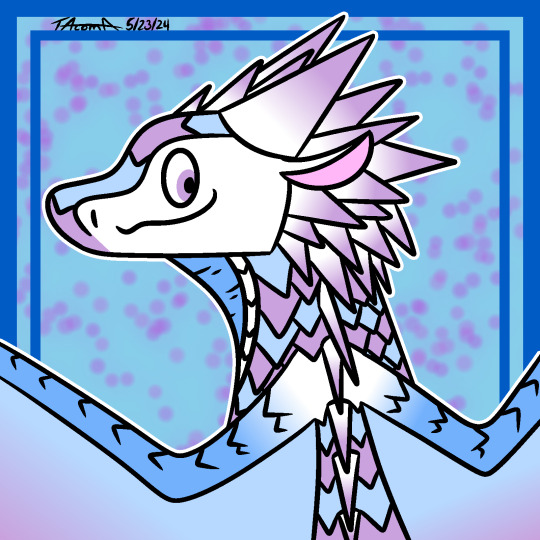
Have a Day! (2024 Version)
You know it's a big day in the Tacoma Nation when Tac draws his WoF-sona lmao.
Today, May 23rd, 2024, marks 7 years since I first got my drawing tablet, so I decided to draw my first ever digital art piece (which is below the cut if you wanna see it)! Of course, as I was way deep into the WoF fandom at the time, it's of Vostok! It's nothing spectacular, but I think it does a good job at showing how my style has evolved over the years.
I think you can definitely see traces of my current style in the original piece [below]. Mainly I think you can see it in the head shape and the way I do the scales. This is also the first time I've drawn Vostok in about a year and a half, the first time I've drawn a dragon from a profile view since June of 2021, and the first time I've drawn Vos outside of a group piece since October of 2020! This is also Vostok's 199th Toyhouse gallery image, so after over 7 years, this mans might soon join Shep in the 200+ TH images club :3
Also to be fair, if you were to see him from this angle, usually the top sides of his wings would be a solid dark blue, but for the sake of this piece, I wanted to make it so you could see his wing membranes :]
Getting this drawing tablet was probably the biggest thing that ever happened in my art life, since it opened up SO many new doors for me, and to think I still use the same little Wacom Intuos after all these years. It's been with me through a lot, that's for sure lmao.
The title here, which I also used for the original piece, came from a line that a friend of mine in high school said all the time, saying that even if your day is good or bad, just try to live in the moment. It's not really connected to the piece itself, but I like the sentiment of it :]
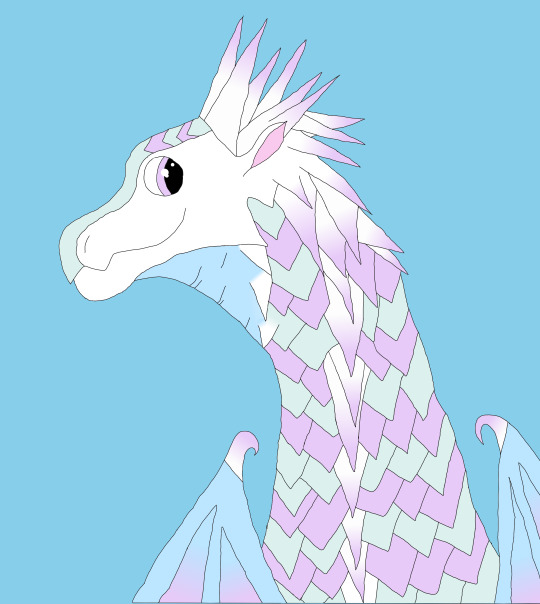
Here's the original, from May 23, 2017! When I made this, plainly I had not yet figured out some key things like lineart stabilization and how I wanted his colors and scales to work lmao. Eventually I figured out how I like to draw him and he stabilized into his current design haha. This was actually traced over another drawing that I had done traditionally prior to getting my drawing tablet. I figured for my first time using it, tracing over one of my pre-existing drawings would be a better way of starting than just a blank slate lol.
#TacDraws#oc: Vostok#art#my art#wings of fire#wof#wof art#wof oc#icewing#icewing oc#WoF icewing#dragon#dragon art#dragon oc#wings of fire oc#redraw#digital art#artists on tumblr
40 notes
·
View notes
Text
Ok, artfight thoughts time! In bullet points for readability's sake!
I've beaten my record for art points/sizing this year! I made 16 artworks on 2021, 38 in 2022, 57 in 2023, and 55 in 2024. (It's been technically 2 less in 57,but I had a couple of pictures with extra characters in 2024)
However, out of these 57 from 2023, there were 14 fullbodies, 8 halfbodies and 36 portraits.
This year I have done 20 portraits, 15 halfbodies and 25 fullbodies- Which did take quite more time than last years' portrait rain! I wish I could've at least given the remaining revenges a portrait. I got 2542.75 points for it!
I've received a bit over 60 drawings this year, which is def a record. First time I end up with an actual negative ratio- 45%. It's been a fight to keep it up.
(if i hadn't got food poisoning, an uti and three periods in july maybe i'd have got the chance to get that up to 50% i've been in spain with and without the S dfhguhdf)
This year has been very enjoyable, besides being sick for a bunch of it. A lot of art- Some of which I've shared, some I'll share once it gets posted. Very honoured about it!
However, it's also the first year I've had to report a bunch of stuff, which (admittedly) has not been handled well by the moderation team. I got a traced attack and a kink-related attack (which i do not allow), I've had friends get the same, and a friend had a whole character traced and stolen. Most of these reports did not really get handled, and even the art thief didn't get banned. That's been quite stressful!
Out of all my attacks, 48 have been revenges and only 7 have been attacks I started myself. I had a list of well over 30 people I wanted to attack, which I barely managed to scratch the surface of
@totesnotaustralian did a wonderful sheet to track artfight data and such, and I have some stats from it! (Ignore the revenge number, I messed up the sheet there jgxhdhjf)

While my first weeks were almost team stardust (friendly fire hell was real), a lot of the later attacks were for Seafoam! And... Here's the character data- With how much they've been drawn each year and in total!

Some fun details and tendencies from this thing:
Vyxander has been drawn the most this year, with 13, which is also the most I've ever got a character drawn in a single artfight. Argyros followed up with 12 on his debut year. Previously, the record was at 10- Which the Onirist got on their debut year.
Some of the new characters this year were fairly popular (like Argy at 12, Starborn at 6). Older characters (other than Vyxander) have been drawn far less in favour of the new ones. Yxala and Relent got 3 attacks each- Which is surprising, given they were the main picks previous years! Poor polycule!
Urion keeps being my most drawn character at a whooping 24, having been drawn 8 times each year. Their post campaign version was more popular on their first year, but has been drawn just 3 times this one- But it's been wonderful art anyhow!!
On the underdogs: Areel has been drawn just once on his debut year (understandably, given his wild armor). Laestis has actually not been drawn, it was a NPC of hers who did, which I counted as a Lae drawing. Osten has been drawn 5 times--compared to being the only one to not get art last year. Mythannae and Yden did not get any art, despite Yden winning that popularity poll I ran a while ago.
and uh, that's quite the long post. I have a lot of art to share from Artfight- Keep an eye for it in this month, because it's quite the backlog!! If you've made it down here, thank you for putting up with this long boy
18 notes
·
View notes
Text


A re-draw with Grif and Simmons! The original is from 2021. Both were done in MS Paint with a mouse (with some art edits to play around with the lines/colors)
Text from the first post below~
Imagine you know this one dude, and you’ve been standing next to him and talking to him pretty much every day, you annoy the heck out of each other, but obviously you wind up becoming friends because how could you not? Now imagine that at some point, you realized you basically had a crush on this dude, and you do NOT want to have a crush on him, because he’s a dork and obviously doesn’t feel the same way, so you ignore it, but the two of you keep standing next to each other and talking every day, for several years. NOW imagine that you went and FELL IN LOVE with this dude, which isn’t fair, because to him you’re just his big goof-ball buddy, no way he could even possibly care about you like that, but you can’t just ignore this anymore, because it has been YEARS, you talk to him and stand next to him pretty much every day, you are just about as close as it is possible to get to somebody (emotionally and physically), but you still have to hold back how you feel, you can only give him a bro-hug and a friendly arm punch, no matter how close you two are, you can’t get closer even though you really WANT to… now imagine you finally tell him, and eventually things work out, he DOES feel the same way, he loves you too, and now you can actually HOLD him, you can cuddle and snuggle as hard as you want, because he wants to hold you too, you both want to hold each other~
(Both versions have Grif hugging Simmons close, pressing his face into Simmons' chest. Simmons has one arm wrapped around Grif, both are smiling happily with their eyes closed. I've always drawn Grif thick and chubby, but I've gotten more practice with making him look both soft and solid. My design for Simmons is tall, somebody who used to be pretty lanky, but he's finally put on some weight, so he's not a string-bean anymore. Grif has long dark brown hair, thick and wavy, with a golden shine to it, and stubble around his jawline. Simmons is a red-head, with bangs parted to the side off-center, and pulled back in a ponytail. Simmons cybord eye and arm are visible on the left-side)
27 notes
·
View notes
Note
i was scrolling through your blog trying to find a comic i think you did about post finn and jake's death with marceline having forgotten they died a long time ago and having a freak out when bubblegum has to remind her they're not around anymore (I couldn't actually find the comic) but i saw a few posts about criticism of the basic concept of Fionna And Cake and I wanted to know how your thoughts on it changed
The comic... hmm... it's this one!
How my thoughts have changed - I expected Fionna and Cake to be as they were in the show. Basically, as soon as the first trailer came out and revealed they were in a modern coffee shop AU, I realised they were actually doing something interesting with the concept of fanfic. I also thought it was more at home with Fionna and Cake's origin as a funny comic drawn by Natasha Allegri, who is the creator of the Bee and Puppycat series.
Before we got any more info, I was very apprehensive. An adult series about Fionna and Cake? That sounds, well, very anti- what the crew wanted to make before. Was this the only thing they could get greenlit?
Thankfully the crew took advantage of their ability to use mature themes and death, instead of doing the worst possible thing and making every joke gross or bloody, though we do get a bit of that in the series...
Overall was very iimpressed with how it turned out. Back in 2021 everyone thought it was going to be a huge letdown compared to Together Again as an ending, but it's a good continuation of Adventure Time without trampling on what the show has done before.
I like particularly that Fionna and Cake seemed to be completely different characters to their show versions. It's way more compelling to have Fionna be a normal person with her own personality who is surprised to find out about magic, rather than a worse version of Finn. I think in particular making her be in her 30s struggling to hold a job, and relating that point to how Simon feels in the present, is why this series had such a strong premise in the end. She was relatable to the viewers and it gave her a connection with another beloved character.
64 notes
·
View notes
Text
i was organizing some files and found all the wip stuff from the previous secret samol for @/seamonsterart (go check out their work!), and these are two of my favorite illustrations ever, so here's some insight into how i made these!
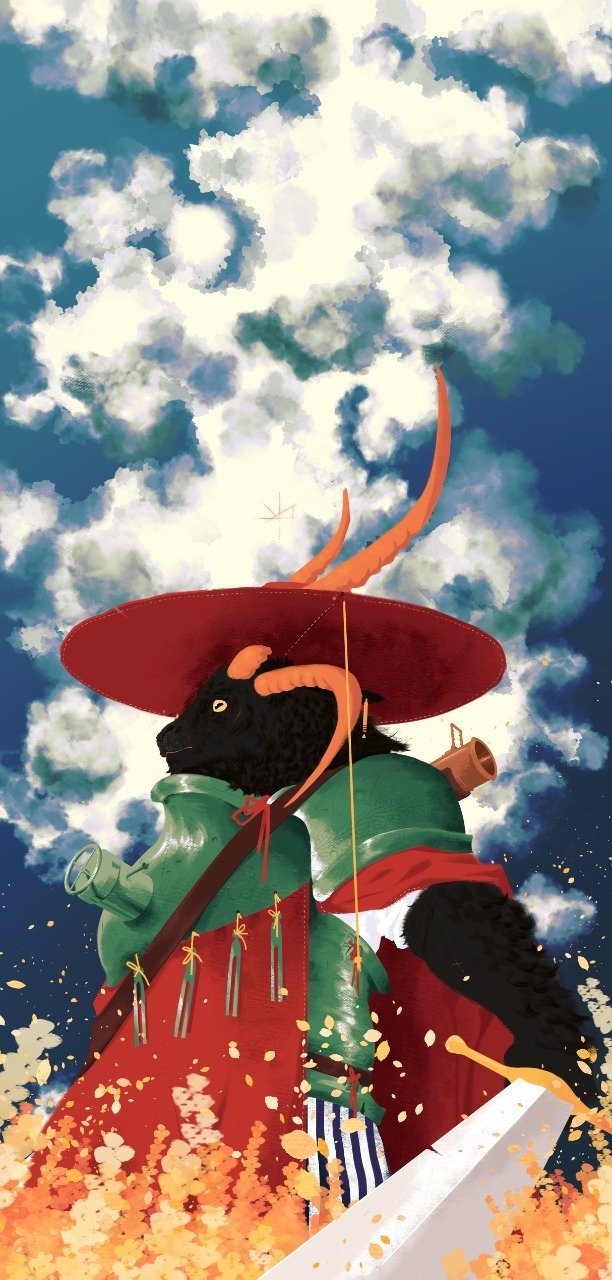
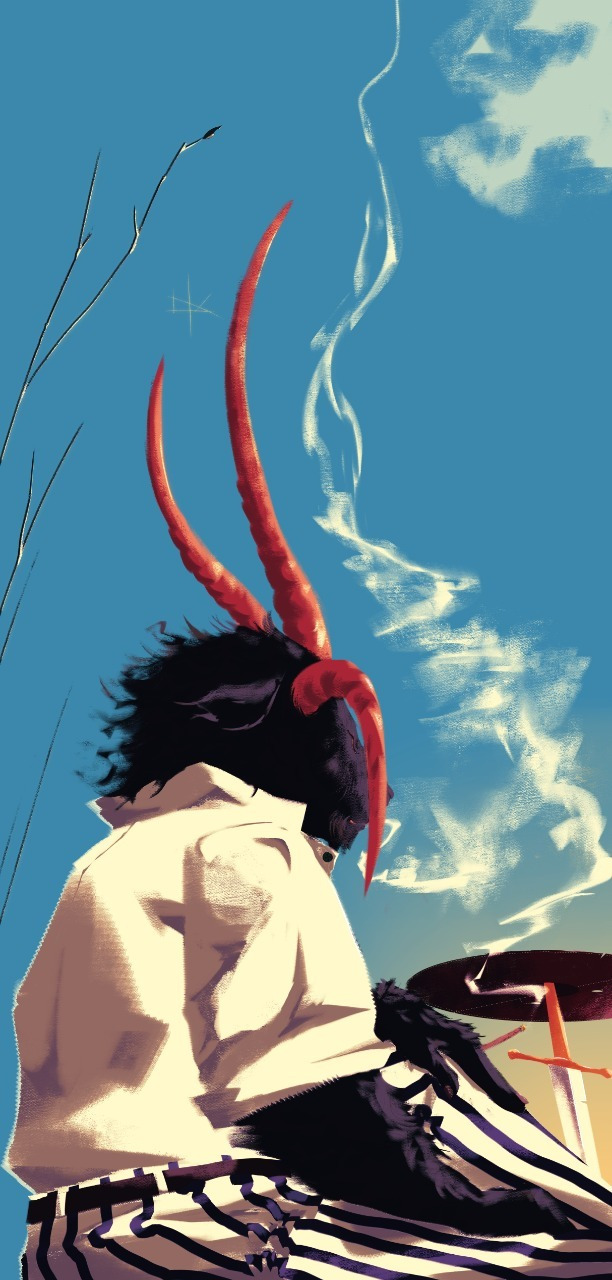
for starters i already had a pretty much finished design for pickman that i had first drawn back in 2021
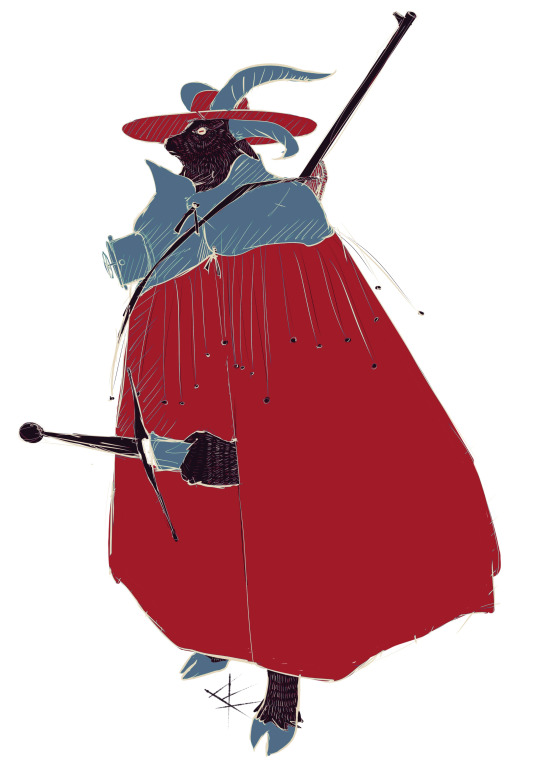
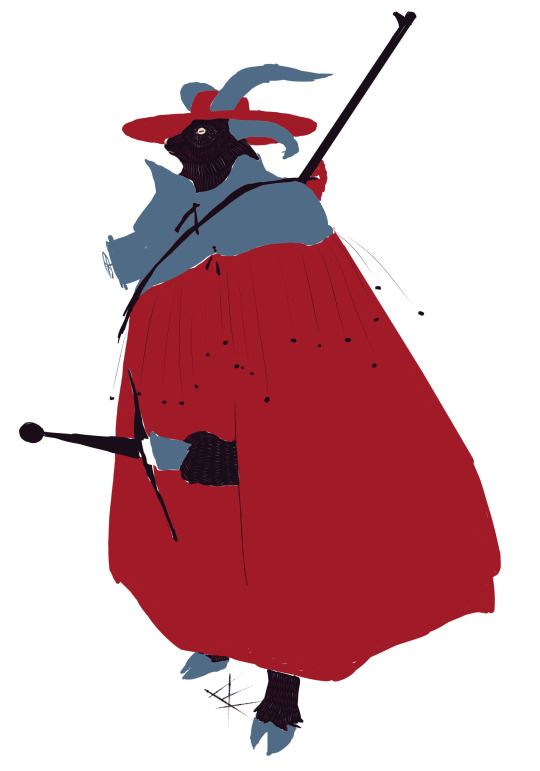
she has a completely wrong gun in this version because i did not remember how it was supposed to look like and couldn't find a description of it anywhere. she's wearing a hat because i forgot it was supposed to be a helm and so i ended up giving her the large hat just because the long horns coming through it are a fun image, though today i cannot imagine her wearing anything else. she already has the sword she takes from the lake skeletons, also. her armor is based on the armor the torumekian soldiers and kushana wear in nausicaa of the valley of the wind, with the incredible neck guard and long cape covering their entire body
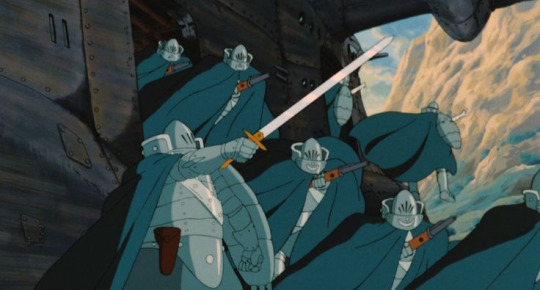

i've always loved these designs and how the plates are evocative of insects, but also how mysterious they look with covered faces and bodies. matter of fact, at this point i had no fucking idea what pickman looked like below the cape.
the second inspiration is the young man from angel's egg.
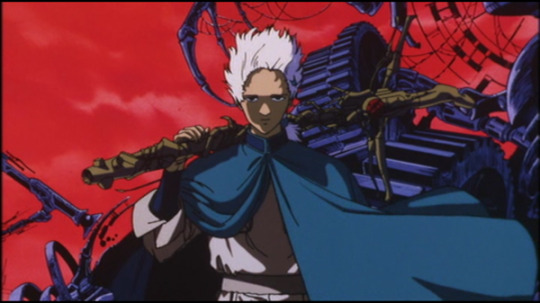
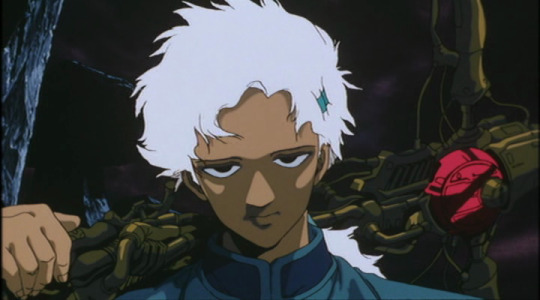
OK, STAY WITH ME. i cannot explain this other that in my head pickman and him are VERY similar characters. the image of the half pulled cape while he holds his sword-cross-thing over his shoulder and the quiet demeanor are pretty fundamental to how i try to make pickman FEEL. i actually wanted her armor to have more piping, pulling from the biomechanical appearance of his sword-cross, but it didn't feel quite right
and the third inspiration is less inspiration and more reference work, the book "arms & armor, a pictorial archive" by carol grafton
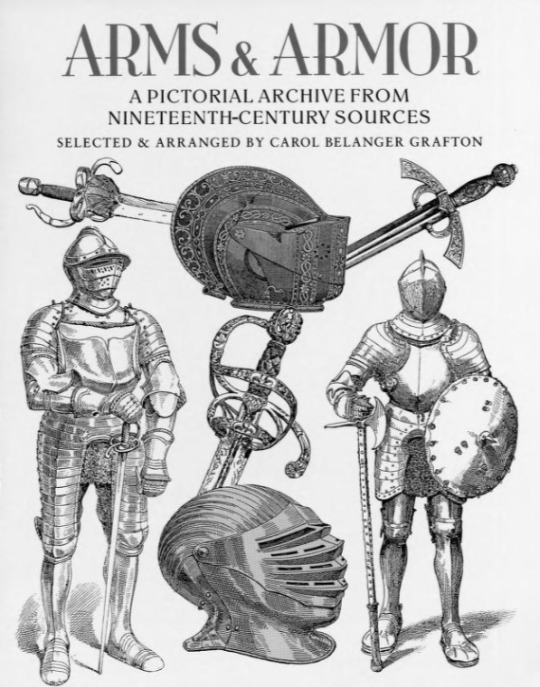
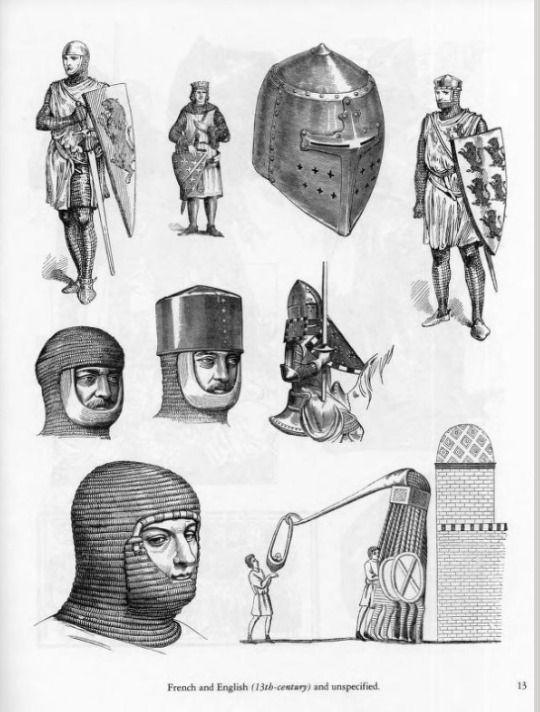
it's a compilation of illustration works sourced from several books from the 19th century. VERY cool book to take a look at historical armor. it's on the internet archive for free!
there was also a fair ammount of looking at goats and sheep, but eventually i reached this after learning i suck at drawing furry designs. big shoutout to the furry community for making so many tutorials available btw. in highlight a very important study of the character.
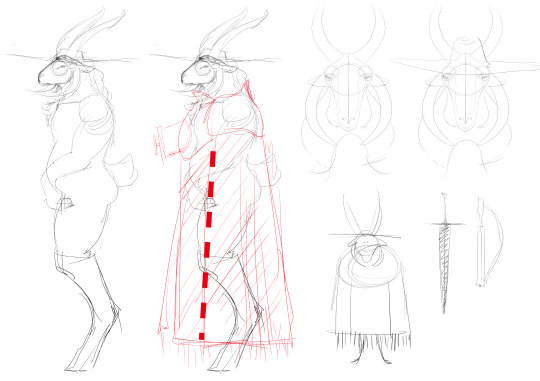
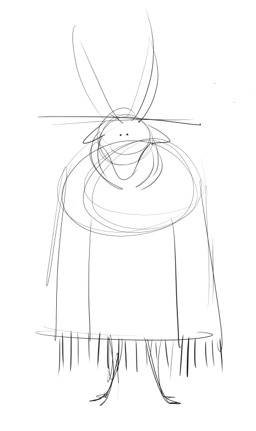
now that i kinda knew what pickman looked like i entered the wonderful phase of "i don't know what the fuck i'm doing" which resulted in a bunch of bad doodles now sitting in a folder dubbed "dev hell". at this point i kinda had an idea for a relaxed scene based on one of the prompts, which i developed for a while on blender but eventually gave up on.
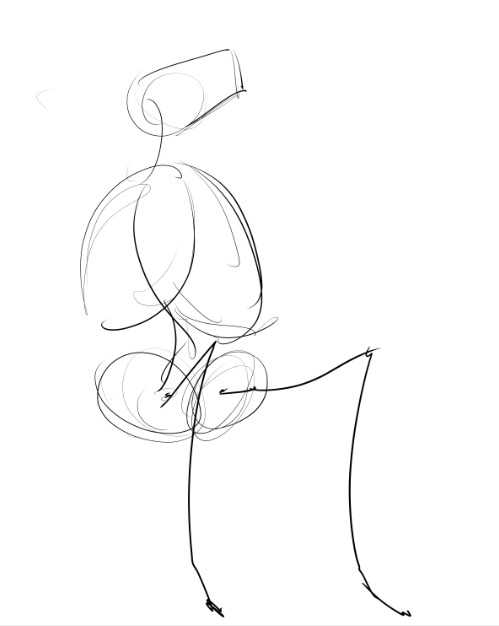
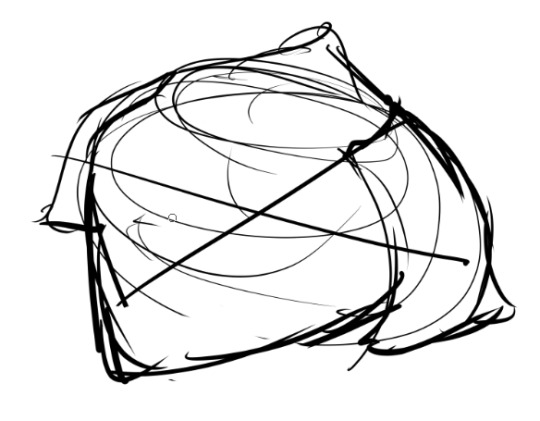
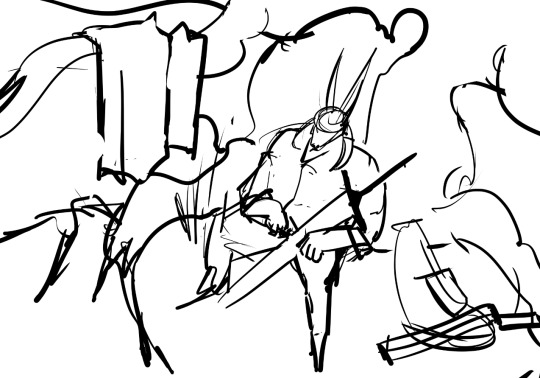
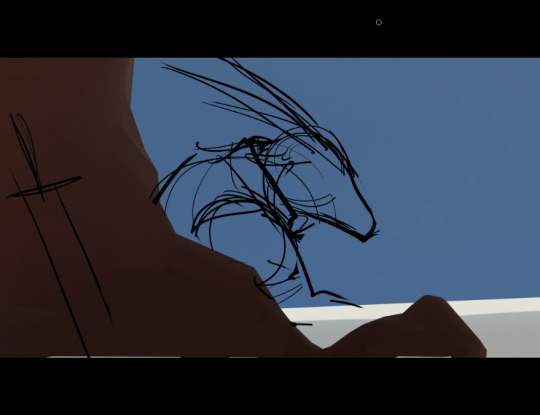
i then moved on to the second prompt, of pickman being badass. i decided on a low angle to make pickman look incredibly tall but the low angle of a goat's head legitimately kicked my ass so i eventually made a goat head on blender and used it to generate references with the help of designdoll. here i made her design a lot more muscular and fat, also, eventually coming to her final design.
the valve on her chestplate looks WRONG to me now, but at the time i was so tired i just rolled with it. the first pass of her armor was in a completely wrong color, which i corrected later on photoshop. i added the little metal forks pulling from her 2021 design, and the idea of little musical forks for atunning to the shape was cool to me. i also corrected her gun after actually learning what the fuck it was supposed to look like. i already knew i wanted her to be standing on the field of canola flowers, and the sky in the background was the last thing i added, also the time when i decided to really make the picture tall.
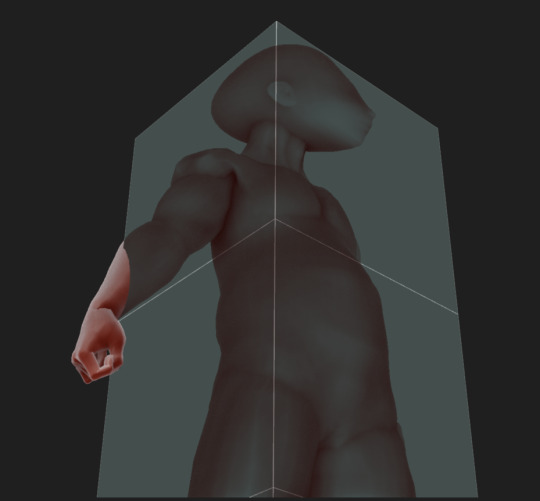


i liked the final result so much i went back and started working on the first prompt again. had a horrible time drawing the horns in the second image which led to this hell cage for building the perspective. im still not confident on the horns on the side of the head. i wanted to bring the atmosphere of a cold winter or fall morning in the second one, and to make pickman seem tired but relaxed. i overall like the second picture a lot more than the first and was very happy with how it came out.
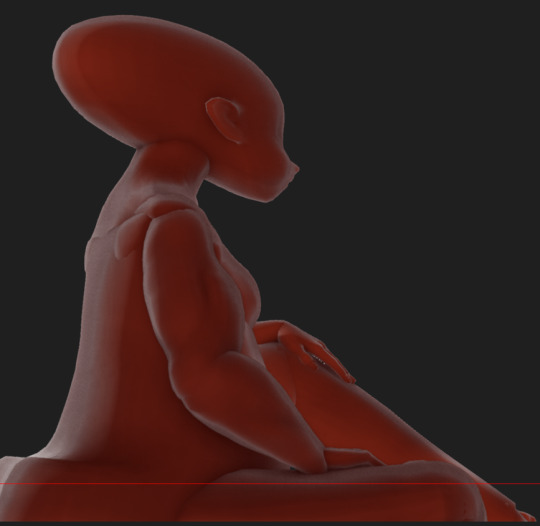
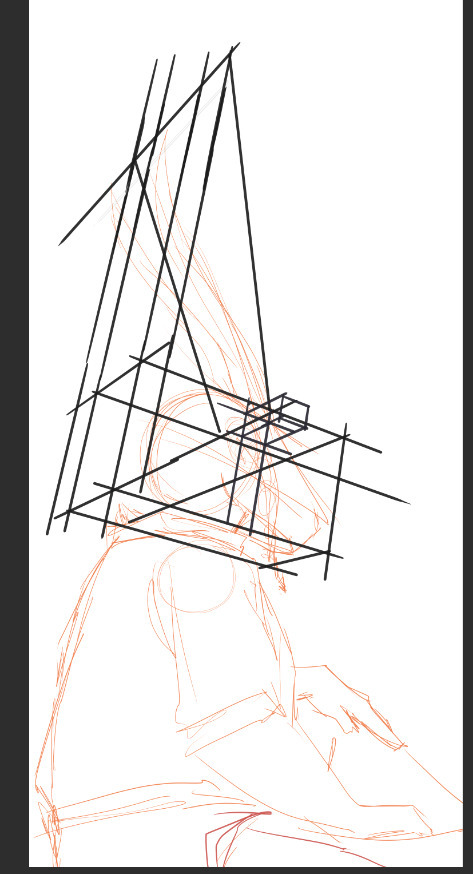
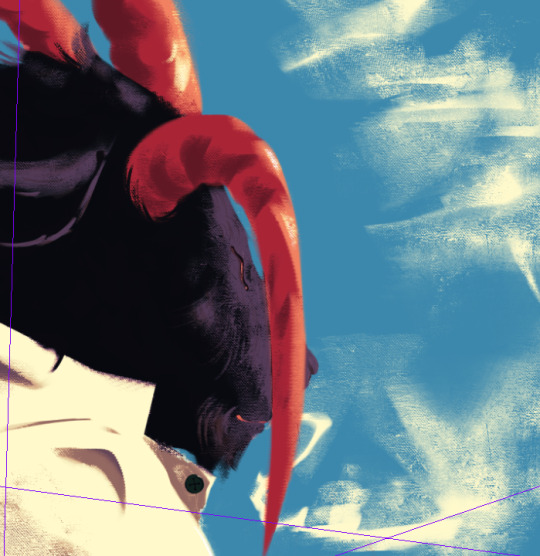
AND THAT'S HOW THE SAUSAGE IS MADE I GUESS. if you read this whole thing then thank you for your time!
#fatt#f@tt#friendsatthetable#friends at the table#pickman#ernestina pickman#sangfielle#wip#breakdown#luketaart#brazilian artists
124 notes
·
View notes
Text
Only Angel
Only Angel has similarities to Meet me in the Hallway, they 2 of the 10 Haylor songs with Hallways. To me, it is related to So it Goes... which refers to when Taylor performed in the 2014 Victoria's Secret show. Harry performed Only Angel at the 2017 VS show. I have always heard this song to be an assurance to Taylor that she is his 'only angel', like in As it was, she cannot be replaced with girls that 'look just like her' in MMIH Possibly because he was seen with Nadine Leopold soon after the 2014 VS show. It also references Van Morrison's Tupelo Honey which Harry included on his mix tape.
youtube
At 2 minutes into this Nashville performance Harry sings "Told her Little Brother" (2.09), further confirmation it is Haylor, with Austin Swift being younger than Taylor unlike Kendall's brother.
Only Angel was last played live in November 2021. It wasn’t at Coachella or after Harry’s House.
Original Lyrics
On 7 December 2023 the demo was leaked with different lyrics. Studio version is like a simplified, shortened and cleaned up radio edit. In the original, the muse has more agency (they knock), Harry has considered proposing 1000 times but it hasn't worked out and it's more explicit. The song also ends, then comes back like their relationship.
Close your eyes, shut your mouth and see That I'm still the only one who's been in love with me I'm just happy getting you stuck in between my teeth And hoping you don't shout about it Now I know a bunch of people who would waste your time But I wouldn't let it happen to a friend of mine We can write ourselves a story without doing lines 'Cause believe me, we can live without it, She's an angel[...] Broke a finger knocking on my bedroom door I got splinters in my knuckles crawling on the floor Could never take you home because your skirt's too short And my mother would be mad about it I must admit I married you a thousand times Had to change my tune when I found out what it’d be like But I meet you in the hallway almost anytime And we won't have to talk about it, yeah, She's an angel[...] She wants to be an angel just you wait and see. But it turns out she’s a devil in between the sheets and believe me I am all about it. Huh. Painted on you on your back, I knew we’d get along. But I caught you staring in the mirror way too long. I could love her if I didn’t think I’d do it wrong. I’m gonna have to take you home, She's an angel[...]
Lyrics
I saw this angel I really saw an angel Open up your eyes, shut your mouth and see That I'm still the only one who's been in love with me I'm just happy getting you stuck in between my teeth And there's nothing I can do about it
The first verse, Harry is so drawn to his muse he can’t help winding up with her. They liken their connection to an addiction in MMIH, Clean and Grapejuice.
The “only one in love with me” is Harry calling himself a narcissist and I think refers to Fool’s Gold where he said “Yeah I know your love's not real / That's not the way it feels /That's not the way you feel”
But, like in Fools Gold and Stockholm Syndrome he can’t help himself, he desperately wants to be with this muse
Broke a finger knocking on your bedroom door I got splinters in my knuckles crawling across the floor Couldn't you take home to mother in a skirt that short But I think that's what I like about it
This verse starts with 2 references that are in other quite sad songs, but set to a dance beat. Something Harry later did so well in As it was:
Taylor also referred to Harry knocking on her door in Suburban Legends but very sadly “You don't knock anymore and my whole life's ruined”
Harry also referred again to being on the floor in Fine Line “And I don't wanna sleep in the dirt”
The short skirt is a reference to Style “And I got that good girl faith and a tight little skirt”
She's an angel Only angel She's an angel My only angel
This line to me is a response to Is it over now? “Your new girl is my clone”. To me, Harry was saying he only has one angel, as in Victoria’s Secret model, Taylor having performed in 2 VS shows in 2013 and 2014.
After 1989 was released and they broke up they both spent a lot of time with a lot of models. Read into that what you will, to me the role the VS after party plays in So it goes and IDWLF, and the clone line has me noodling on if they were both seeking each other rather than the models.
I must admit I thought I'd like to make you mine As I went about my business through the warning signs End up meeting in the hallway every single time And there's nothing we can do about it
I love ‘went about my business and want to make you mine’ to me it encapsulates what I imagine wasted Harry’s chill attitude at that time.
Ending up in hallways links this to MMIH and the 10 other mentions of hallways in their respective songs.
Told it to her brother and she told it to me That she's gonna be an angel, just you wait and see When it turns out she's a devil in between the sheets And there's nothing she can do about it Hey, hey
This line about her brother is thought to narrow the muse to KJ and TS, in the above live performance in Nashville Harry said little brother which would be Austin Swift. Harry also got on with Austin.
To me, she’s an Angel/devil is here is similar to Style, where Taylor had “good girl faith and a tight little skirt” both play on the idea of someone seeming good but being wild. Kiwi is also similar “hard liquor mixed with a bit of intellect”
She's an angel Only angel x3 Wanna die, wanna die, wanna die tonight x3 My only angel She's an angel x3 My-my-my only angel
The refrain is repeating that she’s the only angel for him, and he wants to go to heaven.
Harry included Van Morrison's Tupelo Honey on his Another Man Mix Tape from an article while he was making this album. The outtro "She's an angel", which is also how Tupelo Honey ends. As Harry said to Rolling Stone:
“I don’t know much about Van Morrison’s life, but I know how he felt about this girl, because he put it in a song. So I like working the same way.”
42 notes
·
View notes
Text
I was going through my art folder on my phone and realized how far I've come with how I draw Shay (and her different forms).
Way back in 2021 I drew her for the first time. She effectively came from a dream I had, where I lived her life in one night. But the struggle was I never actually really saw what Shay/I looked like in the dream. I knew what I was, who I was, but not what I looked like, beyond my hands. One of the most spectacular dreams I've ever had, by the way.
So early on when I was streaming, I decided to take a crack at drawing the dragon woman I'd been in the dream. I couldn't even really remember my/her name, although with help from my friends it came to me.
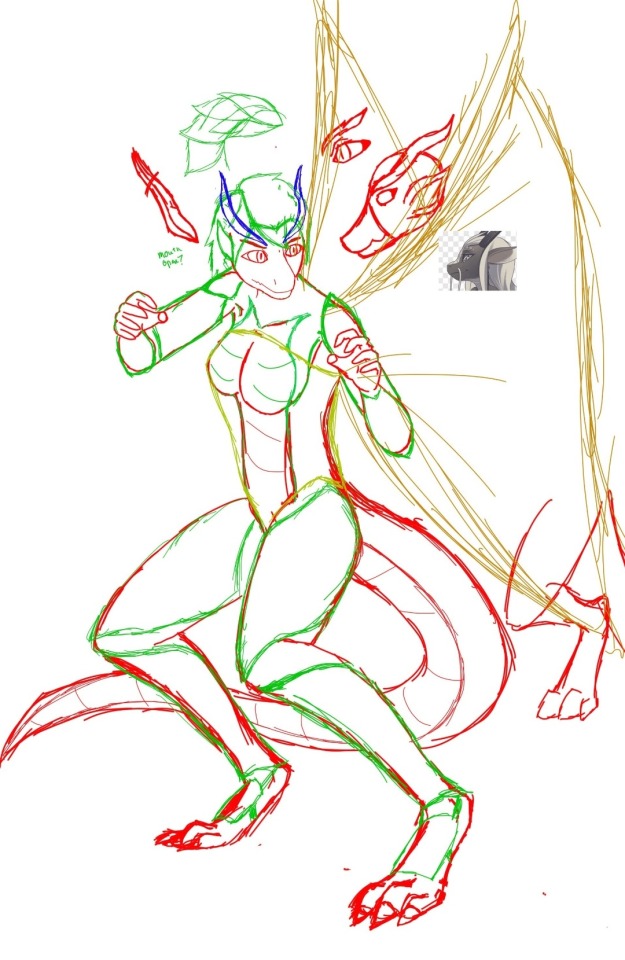
The first sketch was... Rough, at best. I had no clue how to draw an anthro creature, which Shay effectively was. I used multiple references to even sorta rough out what I wanted, and the result was not spectacular. But it was a start.
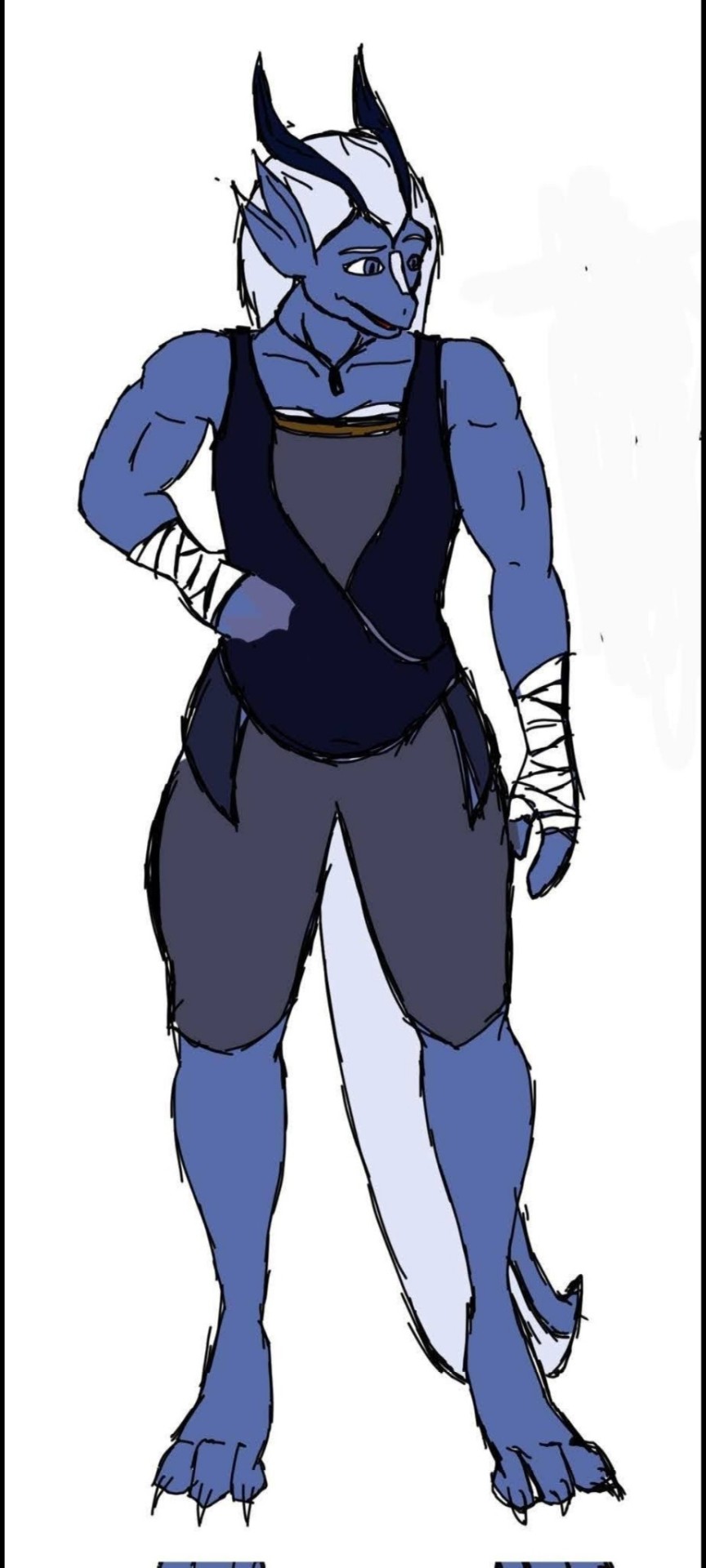
Then I was memeing with my friends about our D&D characters. I fully intended to RP as Shay when we began a campaign. It led to the version above - the first proper drawing where I was mostly happy with her overall design.
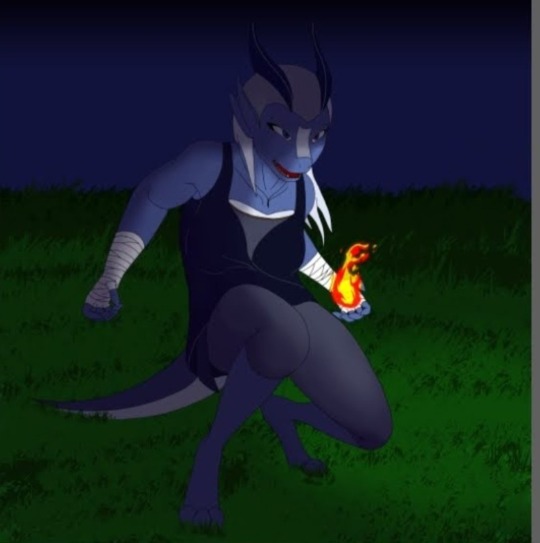
Late 2021 and I tried to push myself a little further, although I still didn't know what I was doing.

Art block hit me like a truck for a few months. When I finally managed to get drawing again, the results were initially really, really bad. But it wasn't too long and I drew what would end up being a far more finalized version of her design, the template for many future works. She was a more agile figure than her design sketch. I adjusted her horns to make more sense anatomically, and to fit better with her hair.
And also I drew abs on her.
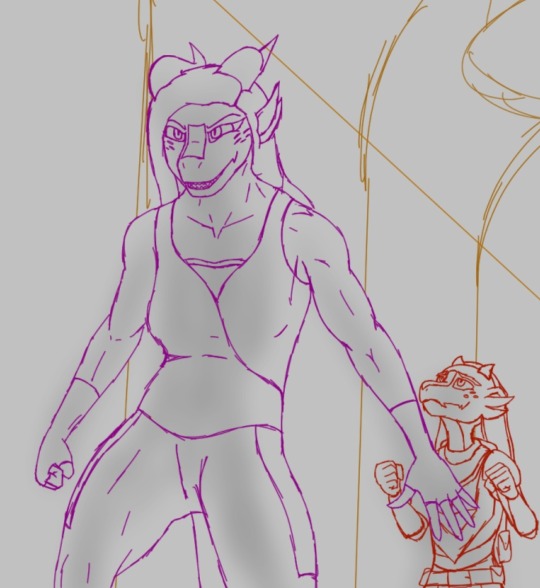
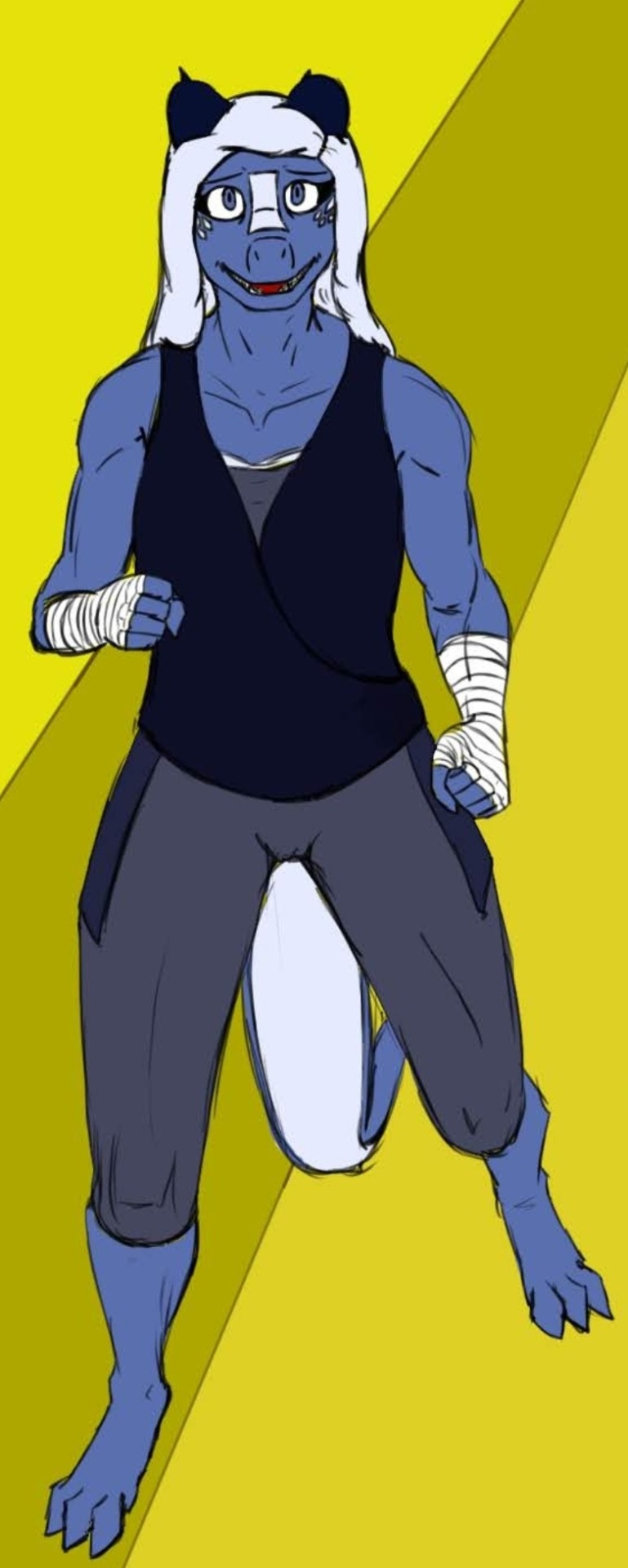
Then there were several more drawings. I touched on alternate versions, put her in some fun situations as self indulgence, tried to experiment with difficult poses. There was a lot of struggle, as I still couldn't quite get her head shape consistent.
Then I found some new resources, and on a whim I drew what's becoming my favorite alternate version of her: Shayaa.
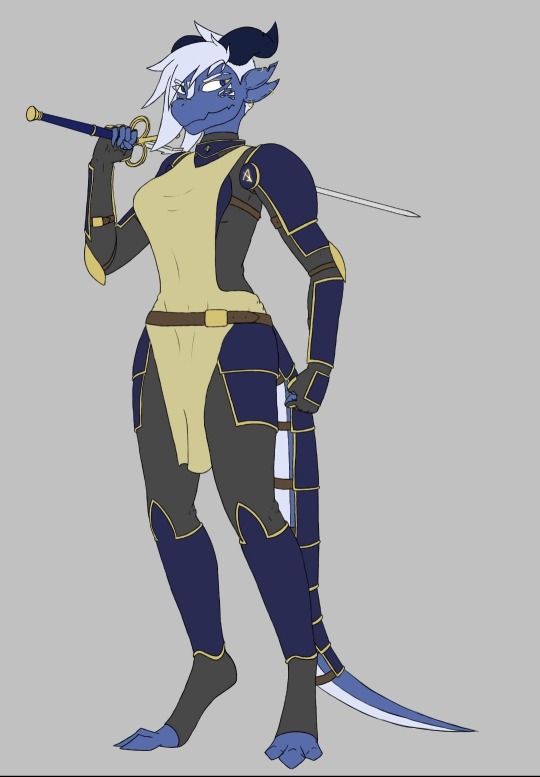
(Flat color iteration shown)
Shayaa was born out of two thoughts. I wanted a version of Shay that was a little thicc, and I wanted a version where she hadn't been abandoned. This ended up with her in armor, and was a leap forward in terms of quality and some design cues. The softer snout, more defined mouth, and thicker horns ended up really helping me draw her more consistently.
I was worried that it was one of those cases where I went beyond my actual ability and wouldn't be able to replicate it, but I was mostly wrong.

I decided I wanted to adjust "prime" Shay's design a bit, to improve her visibly aging and to widen the gap between her and Shayaa to emphasize their differences. I thinned her up a bit, made her muscles more lean, and rounded her features to make her appear more youthful - she's in her early 20s at the start of Godbreaker, but I saw her design as more in her late 20s or early 30s. She was always intended to be more lean than I'd drawn her, but skill issue. I also kinda hated parts of her default outfit, they seemed off and weren't the easiest to draw.
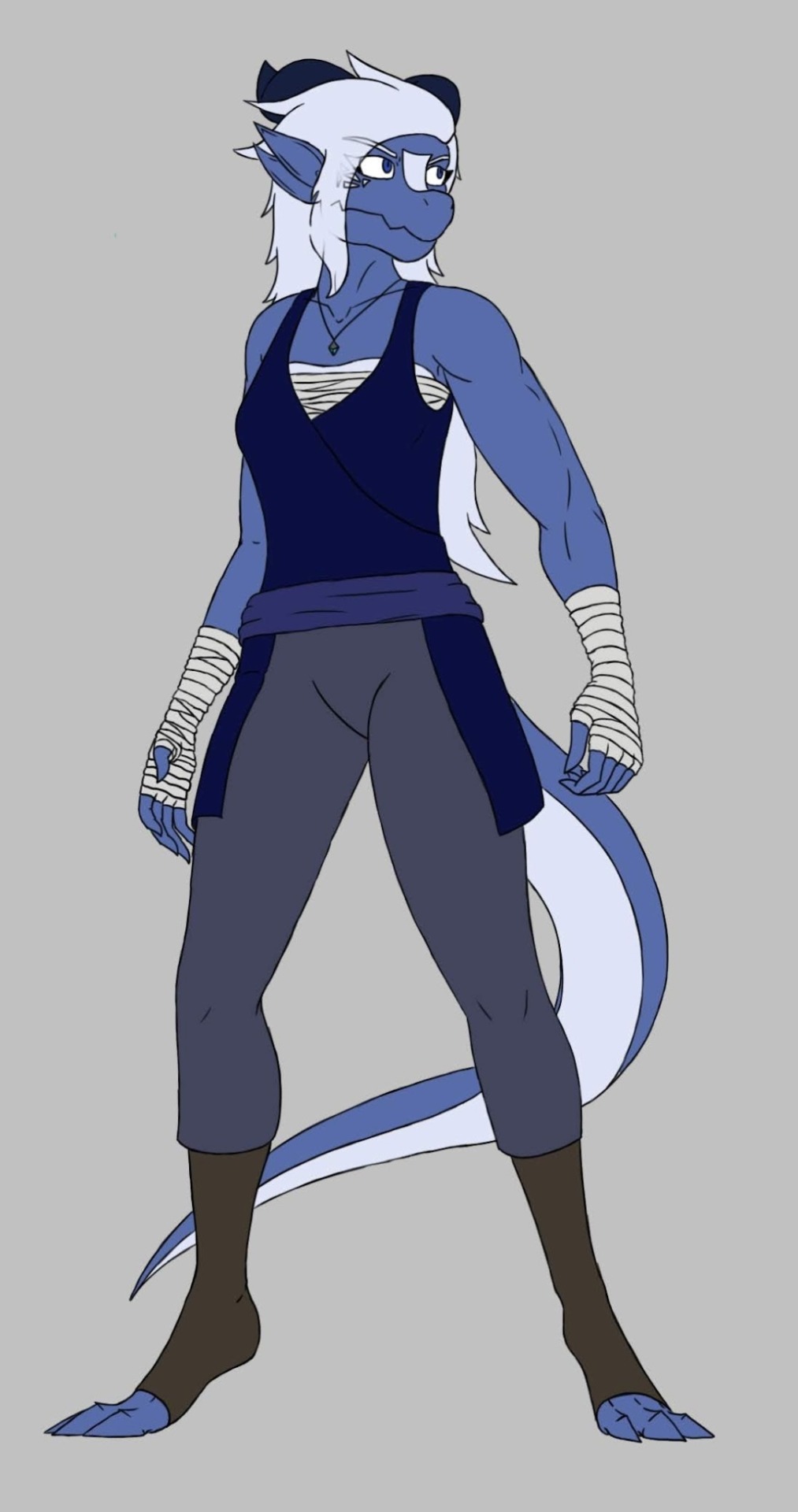
And now? I'm pretty satisfied with her design. She looks younger and more lean, and ideally a little less "civilized." Her hair got spikier to make it easier for me to draw - I suck at floofy hair. She's still pretty big, at 6'7" tall, but she doesn't look like a brick house anymore (nothing wrong with that, I love brick houses, she was just not intended to be that).
But yeah. Going through the old art, a lot of which I can't add to this post, it really hit home to me how much in such a relatively short time she's changed since the first real sketch, how much I've changed...
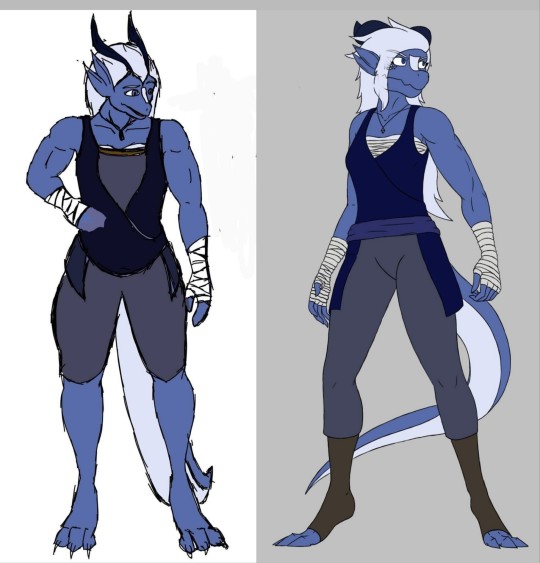
...And how much has stayed the same.
Aaaand to not end on any sort of deep moment, holy shit her old feet were HUGE.
31 notes
·
View notes